#may 2021 entry
Explore tagged Tumblr posts
Photo

@prettywarriors minimahoumarch may edition, week 2, horror kaitou
on the left there’s a variation on the Little Mermaid... which I personally don’t like how it turned out, though digital better than pen
on the right is a ghost-themed kaitou with a pet mimic treasure box. I can’t believe I haven’t seen of a kaitou/mimic duo before
#mini mahou march#mini mahou may#phantom thief#2023#color#fairytale thief#fairytale thief: little mermaid#mermaid parallels my 2021 entry which was a phantom thief pirate and ghost begins a trend with last week's one with the boxes as main item
29 notes
·
View notes
Text
Epic Systems, a lethal health record monopolist

Epic Systems makes the dominant electronic health record (EHR) system in America; if you're a doctor, chances are you are required to use it, and for every hour a doctor spends with a patient, they have to spend two hours doing clinically useless bureaucratic data-entry on an Epic EHR.
How could a product so manifestly unfit for purpose be the absolute market leader? Simple: as Robert Kuttner describes in an excellent feature in The American Prospect, Epic may be a clinical disaster, but it's a profit-generating miracle:
https://prospect.org/health/2024-10-01-epic-dystopia/
At the core of Epic's value proposition is "upcoding," a form of billing fraud that is beloved of hospital administrators, including the "nonprofit" hospitals that generate vast fortunes that are somehow not characterized as profits. Here's a particularly egregious form of upcoding: back in 2020, the Poudre Valley Hospital in Ft Collins, CO locked all its doors except the ER entrance. Every patient entering the hospital, including those receiving absolutely routine care, was therefore processed as an "emergency."
In April 2020, Caitlin Wells Salerno – a pregnant biologist – drove to Poudre Valley with normal labor pains. She walked herself up to obstetrics, declining the offer of a wheelchair, stopping only to snap a cheeky selfie. Nevertheless, the hospital recorded her normal, uncomplicated birth as a Level 5 emergency – comparable to a major heart-attack – and whacked her with a $2755 bill for emergency care:
https://pluralistic.net/2021/10/27/crossing-a-line/#zero-fucks-given
Upcoding has its origins in the Reagan revolution, when the market-worshipping cultists he'd put in charge of health care created the "Prospective Payment System," which paid a lump sum for care. The idea was to incentivize hospitals to provide efficient care, since they could keep the difference between whatever they spent getting you better and the set PPS amount that Medicare would reimburse them. Hospitals responded by inventing upcoding: a patient with controlled, long-term coronary disease who showed up with a broken leg would get coded for the coronary condition and the cast, and the hospital would pocket both lump sums:
https://pluralistic.net/2024/06/13/a-punch-in-the-guts/#hayek-pilled
The reason hospital administrators love Epic, and pay gigantic sums for systemwide software licenses, is directly connected to the two hours that doctors spent filling in Epic forms for every hour they spend treating patients. Epic collects all that extra information in order to identify potential sources of plausible upcodes, which allows hospitals to bill patients, insurers, and Medicare through the nose for routine care. Epic can automatically recode "diabetes with no complications" from a Hierarchical Condition Category code 19 (worth $894.40) as "diabetes with kidney failure," code 18 and 136, which gooses the reimbursement to $1273.60.
Epic snitches on doctors to their bosses, giving them a dashboard to track doctors' compliance with upcoding suggestions. One of Kuttner's doctor sources says her supervisor contacts her with questions like, "That appointment was a 2. Don’t you think it might be a 3?"
Robert Kuttner is the perfect journalist to unravel the Epic scam. As a journalist who wrote for The New England Journal of Medicine, he's got an insider's knowledge of the health industry, and plenty of sources among health professionals. As he tells it, Epic is a cultlike, insular company that employs 12.500 people in its hometown of Verona, WI.
The EHR industry's origins start with a GW Bush-era law called the HITECH Act, which was later folded into Obama's Recovery Act in 2009. Obama provided $27b to hospitals that installed EHR systems. These systems had to more than track patient outcomes – they also provided the data for pay-for-performance incentives. EHRs were already trying to do something very complicated – track health outcomes – but now they were also meant to underpin a cockamamie "incentives" program that was supposed to provide a carrot to the health industry so it would stop killing people and ripping off Medicare. EHRs devolved into obscenely complex spaghetti systems that doctors and nurses loathed on sight.
But there was one group that loved EHRs: hospital administrators and the private companies offering Medicare Advantage plans (which also benefited from upcoding patients in order to soak Uncle Sucker):
https://www.ncbi.nlm.nih.gov/pmc/articles/PMC8649706/
The spread of EHRs neatly tracks with a spike in upcharging: "from 2014 through 2019, the number of hospital stays billed at the highest severity level increased almost 20 percent…the number of stays billed at each of the other severity levels decreased":
https://oig.hhs.gov/oei/reports/OEI-02-18-00380.pdf
The purpose of a system is what it does. Epic's industry-dominating EHR is great at price-gouging, but it sucks as a clinical tool – it takes 18 keystrokes just to enter a prescription:
https://jamanetwork.com/journals/jamanetworkopen/fullarticle/2729481
Doctors need to see patients, but their bosses demand that they satisfy Epic's endless red tape. Doctors now routinely stay late after work and show up hours early, just to do paperwork. It's not enough. According to another one of Kuttner's sources, doctors routinely copy-and-paste earlier entries into the current one, a practice that generates rampant errors. Some just make up random numbers to fulfill Epic's nonsensical requirements: the same source told Kuttner that when prompted to enter a pain score for his TB patients, he just enters "zero."
Don't worry, Epic has a solution: AI. They've rolled out an "ambient listening" tool that attempts to transcribe everything the doctor and patient say during an exam and then bash it into a visit report. Not only is this prone to the customary mistakes that make AI unsuited to high-stakes, error-sensitive applications, it also represents a profound misunderstanding of the purpose of clinical notes.
The very exercise of organizing your thoughts and reflections about an event – such as a medical exam – into a coherent report makes you apply rigor and perspective to events that otherwise arrive as a series of fleeting impressions and reactions. That's why blogging is such an effective practice:
https://pluralistic.net/2021/05/09/the-memex-method/
The answer to doctors not having time to reflect and organize good notes is to give them more time – not more AI. As another doctor told Kuttner: "Ambient listening is a solution to a self-created problem of requiring too much data entry by clinicians."
EHRs are one of those especially hellish public-private partnerships. Health care doctrine from Reagan to Obama insisted that the system just needed to be exposed to market forces and incentives. EHRs are designed to allow hospitals to win as many of these incentives as possible. Epic's clinical care modules do this by bombarding doctors with low-quality diagnostic suggestions with "little to do with a patient’s actual condition and risks," leading to "alert fatigue," so doctors miss the important alerts in the storm of nonsense elbow-jostling:
https://www.ncbi.nlm.nih.gov/pmc/articles/PMC5058605/
Clinicians who actually want to improve the quality of care in their facilities end up recording data manually and keying it into spreadsheets, because they can't get Epic to give them the data they need. Meanwhile, an army of high-priced consultants stand ready to give clinicians advise on getting Epic to do what they need, but can't seem to deliver.
Ironically, one of the benefits that Epic touts is its interoperability: hospitals that buy Epic systems can interconnect those with other Epic systems, and there's a large ecosystem of aftermarket add-ons that work with Epic. But Epic is a product, not a protocol, so its much-touted interop exists entirely on its terms, and at its sufferance. If Epic chooses, a doctor using its products can send files to a doctor using a rival product. But Epic can also veto that activity – and its veto extends to deciding whether a hospital can export their patient records to a competing service and get off Epic altogether.
One major selling point for Epic is its capacity to export "anonymized" data for medical research. Very large patient data-sets like Epic's are reasonably believed to contain many potential medical insights, so medical researchers are very excited at the prospect of interrogating that data.
But Epic's approach – anonymizing files containing the most sensitive information imaginable, about millions of people, and then releasing them to third parties – is a nightmare. "De-identified" data-sets are notoriously vulnerable to "re-identification" and the threat of re-identification only increases every time there's another release or breach, which can used to reveal the identities of people in anonymized records. For example, if you have a database of all the prescribing at a given hospital – a numeric identifier representing the patient, and the time and date when they saw a doctor and got a scrip. At any time in the future, a big location-data breach – say, from Uber or a transit system – can show you which people went back and forth to the hospital at the times that line up with those doctor's appointments, unmasking the person who got abortion meds, cancer meds, psychiatric meds or other sensitive prescriptions.
The fact that anonymized data can – will! – be re-identified doesn't mean we have to give up on the prospect of gleaning insight from medical records. In the UK, the eminent doctor Ben Goldacre and colleagues built an incredible effective, privacy-preserving "trusted research environment" (TRE) to operate on millions of NHS records across a decentralized system of hospitals and trusts without ever moving the data off their own servers:
https://pluralistic.net/2024/03/08/the-fire-of-orodruin/#are-we-the-baddies
The TRE is an open source, transparent server that accepts complex research questions in the form of database queries. These queries are posted to a public server for peer-review and revision, and when they're ready, the TRE sends them to each of the databases where the records are held. Those databases transmit responses to the TRE, which then publishes them. This has been unimaginably successful: the prototype of the TRE launched during the lockdown generated sixty papers in Nature in a matter of months.
Monopolies are inefficient, and Epic's outmoded and dangerous approach to research, along with the roadblocks it puts in the way of clinical excellence, epitomizes the problems with monopoly. America's health care industry is a dumpster fire from top to bottom – from Medicare Advantage to hospital cartels – and allowing Epic to dominate the EHR market has somehow, incredibly, made that system even worse.
Naturally, Kuttner finishes out his article with some antitrust analysis, sketching out how the Sherman Act could be brought to bear on Epic. Something has to be done. Epic's software is one of the many reasons that MDs are leaving the medical profession in droves.
Epic epitomizes the long-standing class war between doctors who want to take care of their patients and hospital executives who want to make a buck off of those patients.

Tor Books as just published two new, free LITTLE BROTHER stories: VIGILANT, about creepy surveillance in distance education; and SPILL, about oil pipelines and indigenous landback.
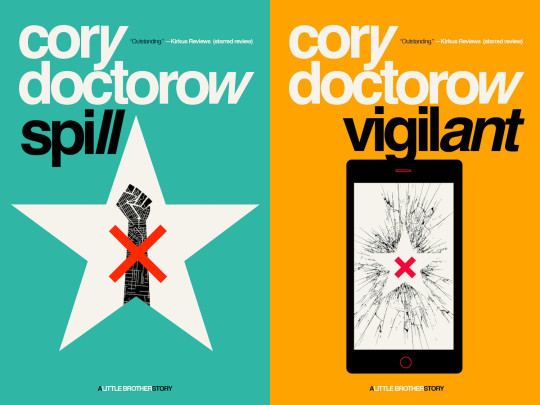

If you'd like an essay-formatted version of this post to read or share, here's a link to it on pluralistic.net, my surveillance-free, ad-free, tracker-free blog:
https://pluralistic.net/2024/10/02/upcoded-to-death/#thanks-obama

Image: Flying Logos (modified) https://commons.wikimedia.org/wiki/File:Over_$1,000,000_dollars_in_USD_$100_bill_stacks.png
CC BY-SA 4.0 https://creativecommons.org/licenses/by-sa/4.0/deed.en
#pluralistic#ehrs#robert kuttner#tres#trusted research environments#ben goldacre#epic#epic systems#interoperability#privacy#reidentification#deidentification#thanks obama#upcoding#Hierarchical Condition Category#medicare#medicaid#ai#American Recovery and Reinvestment Act#HITECH act#medicare advantage#ambient listening#alert fatigue#monopoly#antitrust
820 notes
·
View notes
Text
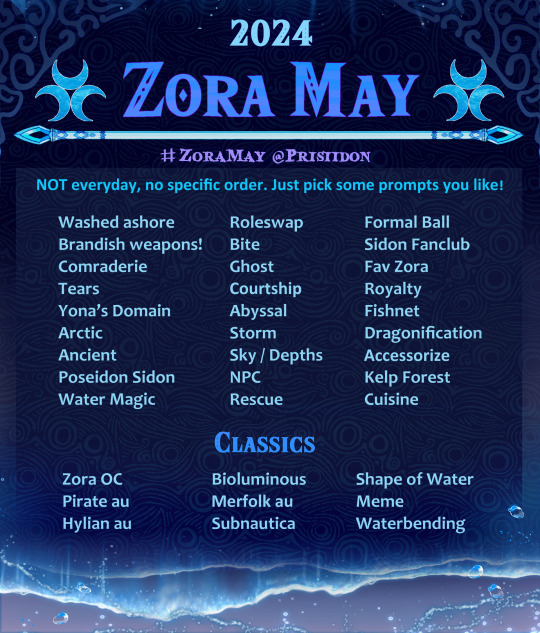
✨ Zora May 2024 ✨ 6th year let's gO 🐬
Guidelines: Tag as #Zora May! Not everyday, no specific order, just pick some prompts you like! For: art/writing, canon zora and zora ocs~ Past prompts can be used, and you can merge prompts too 🐟 I’ll also rb entries!
Design a Zora Masterpost
Entries: tumblr entries | twitter entries | old twitter entries Previous events: 2023 | 2020-2021 | 2019 | 2018
#zora may#legend of zelda#totk#tears of the kingdom#botw#breath of the wild#tloz#loz#twilight princess#art challenge#art#writing#pri posts
622 notes
·
View notes
Text
wtf is dracula daily?
i’ve seen a couple people ask this question on my posts about it, so i thought i’d go ahead and clear it up here!
ok so, the classic horror novel “dracula” is an epistolary novel - that means it’s told via letters, diary entries, ship logs, and news articles. (technically the term “epistolary novel” refers to works told solely through letters or emails, but many have expanded it to mean any work that is told via in-universe documents, hence why diaries and logs often get included as well. “frankenstein” is another classic example; the whole framing device is robert walton is recounting the story he heard from victor to his sister via letter. a modern example would be “several people are typing,” which is told via slack messages, or “the perks of being a wallflower,” which is told via letters from charlie to his anonymous pen pal, which is functionally more like you’re reading his diary.)
because of the nature of the narrative, we actually know the exact day nearly everything in dracula happens - the letters, news articles, diary entries, etc. are all dated.
“dracula daily” is a substack project where the novel is broken up into parts, with people who are subscribed to the project getting emails every day something in dracula happens - for example, the novel opens with jonathan harker’s journal entry on may 3, so on may 3, subscribers are emailed that entry. the action of dracula takes place from may 3 - november 6, plus an epilogue set some years later. the project started in 2021 (i think), but fucking BLEW UP in 2022, and they’re doing it again this year! lots of us are very excited - especially people like me who fell behind last time.
why not just read the book?
valid! due to some parts of dracula being told out of chronological order, dracula daily does reorder some things. for example, the first section of dracula is told entirely from jonathan harker’s pov, then the second section switches the pov to mina murray. their sections have some overlap in the timeline, so dracula daily jumps back and forth between their perspectives.
if you want to read the book as bram stoker intended, dracula daily may not be for you. but for a lot of people (myself included!), it breaks up a very long text into easily digestible chunks (....mostly. there is one entry that is 10k words), and the fact that it’s a big project means there are a lot of people reading along with you.
i think there’s also something valuable about experience the slow revelation of wtf is going on along with the characters. the book which you might otherwise get through in a few days is stretched out into months of suspense and agony as you wait for the other shoe to drop, and it’s great.
plus, the whiplash between “jonathan harker’s neverending horror” vs “lucy is basically on the bachelorette” that you get in dracula daily is very very funny.
how do i sign up?
right here! and if you sign up and fall behind in the emails, no worries - the dracula daily website posts past entries so you can catch up.
what if i prefer audiobooks?
have i got great news for you!
like i mentioned before, i couldn’t keep up with the emails last year. part of it is that it is much easier for me to focus on an audiobook or keep up with a podcast than it is for me to sit down and read, especially with longer entries.
this year, there is going to be a podcast titled “re: dracula” that was inspired by dracula daily. every episode will be a dracula daily entry, with a full voice cast! (seriously, if you listen to british podcasts, you will recognize some of these names. the magnus archives and wooden overcoats girlies are WINNING.) you can find that here.
there is also a podcast called “cryptic canticles” that has an already-completed audiodrama of dracula that i’m told is also extremely good, and was also broken up by date. you can find that here.
why do i keep hearing about paprika/the boyfriend squad/lizard fashion/cowboys?
you’ll see.
oh god am i gonna hear about this nerd shit for the rest of the year
yes. sorry.
3K notes
·
View notes
Note
Hello, I want to congratulate for gaining such big audience on this blog. Also wanted to say thank you for all your hard work. You are one of the blogs that made me come to this fandom in 2020-2021.And thanks for all emotions that you're precious writtings gave me.
As for headcanons, can you please write another "How it to be friends with... " but with Leona, Sebek, Jamil, Ortho and Deuce? The first one was cute and funny
Have a nice day and stay hydrated ����💐
Thank you for your support!!
It’s been so long, I forgot I had written friend headcanons in the past 😅 (They’re here if you’re interested! Featuring Idia, Riddle, Ruggie, Floyd, and Kalim~)
Curiouser and Curiouser...

You do many of the typical things that friendly schoolmates do together: walking to class, collaborating on assignments, eating lunch in the cafeteria, studying, etc. You even get into trouble together, though Deuce attempts to be the "honors student" that keeps you two out of it. (He just ends up getting dragged into the situation with you anyway.)
He’s pretty low on pocket money, but if he notices that you don’t have much to eat yourself or you’ve forgotten or skipped over a meal, Deuce offers whatever he has on him. A protein bar, a juice box, whatever! You can always share, right?
The first to throw a punch in your honor! … Okay, maybe that’s not something to be so proud of, but he’ll still do it if someone’s really rude to you. Deuce will at least try to get them to apologize. If they put hands on you though, all bets are off.
Eager to help! Is your phone busted? Hand it to Deuce, he’ll try tinkering with it until it’s operational again. The snack you paid for isn’t falling out of the vending machine? He’ll kick the crap out of it until your chosen snack falls out (along with about 10 other items).
His mom knows all about you because Deuce is constantly telling her about his cool new buddy. Sometimes you’ll walk in on him on the phone and he’ll put his mom on speaker so you can say hi to her. She often thanks you for “looking out” for Deuce while she’s not there—he needs more people like you to support him!
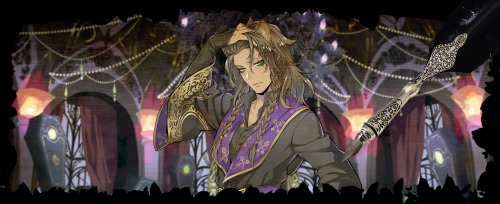
Being friends with Leona grants you a number of "privileges" (which is what he calls them). These so-called "privileges" include: entry to Savanaclaw and/or the Botanical Gardens (without risking the threat of being wailed on to get out), slightly more patience when you call out to him in public, and the random chance for him to chuck his credit card at you and command you to run an errand for him. ("While you're at it, buy yourself something nice for the trouble," he adds.) How... kind (?) of him, right?
He's the kind of friend you have to practically harass to convince him to get out and do something with you. Leona would rather snooze or hang out indoors reading or playing chess or logic games. Sometimes you have no choice but to bend to his whims because otherwise you're not seeing him at all. It's his way or the highway!
If he's in the mood, he'll play a little rough. Leona's not exactly super affectionate (like, he's not going to hug you), but he'll occasionally ruffle your hair or get you in a headlook and noogie you. It's his way of greeting you or saying, "job well done".
A lot of your conversations with Leona are essentially extended exchanging of quips. He’s still every bit as sarcastic and snarky as he is with his enemies, perhaps even moreso with you. It’s not done out of animosity, but rather because Leona wants to keep you on your toes. After all, he let you into his pack—so you can keep up with him, can’t you?
In spite of how lackadaisical he may appear, Leona's the first person you know you can go to if you ever need help. A school assignment, physical training, life advice, whatever. He has this way of saying what you need to hear (even if it isn’t pleasant; he's a realist, not an optimist, and he's not going to sugarcoat it for you) and kicks your ass into high gear.
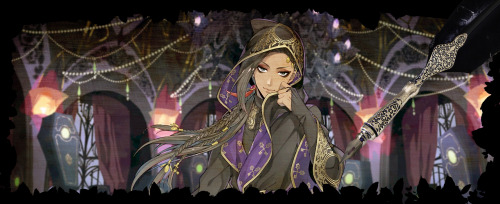
Definitely the “mom friend”, though out of habit and not because he wants to or actively tries to be. The kind of guy to fuss over whether you’re eating enough or sleeping at an appropriate time.
He often looks frazzled when you greet him in the halls or hang out after classes (which he so rarely does anyway because he’s usually for his hands full and with some Kalim-related task). Jamil vents to you later about what he has to put up with. You’ve never heard him use such colorful language and creative phrases outside of these vents. (He makes you swear to secrecy.)
On hangouts, Jamil comes overprepared. Even if it’s not raining, he brings an umbrella. Even if it’s not sunny, he brings sunscreen and bug spray. In fact, Jamil always shows up with this massive bag of what he calls “essentials”. First aid kit, water bottles, hand sanitizer, hand cream, portable battery, snacks, lip balm, sewing kit, travel toiletries, pens, spare eating utensils, a flashlight, a multitool, sunglasses, a notebook, a mirror, tissues—
His homemade lunches look so good; you tend to stare with quiet longing until Jamil sighs and asks if you would care for some. He acts like it’s a slight inconvenience to him (to salvage his pride and to come off as humble), but really he’s fishing for an excuse to share his food and get a compliment from you. In exchange for feeding you, you feed his ego.
Jamil insists he doesn’t need you to come to his basketball games, he can play just fine without you there. Well, that doesn’t stop you from showing up with a homemade poster to wave around and shouting his name. He acts embarrassed about it and scolds you afterwards, but he’s secretly pleased to have your support.

Ortho's the friend you feel the instinctive need to protect (on account of his small, boyish stature)--but don't be fooled! It's him who's jumping to shoot a laser beam at people who pick on you and you having to hold him back from firing.
He's cute and he knows it. Whenever he wants to get his way (like, say he wants to pick what you do today), he'll put his acting chops to use and pretend to get all sad or claim that you're bullying some innocent little kid to win the disagreement.
You play a lot of video games and board games together but you can never quite win most of the time. Ortho's advanced learning algorithms allow him to learn your playstyles and adapt on the fly, leading to him cinching victory after victory. He takes it easy on you once in a while though, just because it wouldn't be fun to go entirely unbeaten! More recently, you've been really into this racing game called Sugar Rush--and Ortho likes to play dirty and targets you with all the traps he can get his hands on.
You have movie nights too! Sometimes it's mainstream productions but sometimes Ortho shows you sneak peeks of the Film Research Club's latest projects (where he stars). He doesn't eat or drink, so you can monopolize all the snacks and chill as Ortho gets the film rolling... from himself! He has a built-in projector which makes it possible to watch movies on any wall.
Being besties with a supercomputer has its perks. Ortho can fact check you on the spot and provide any and all information you might be looking for in the blink of an eye.

Sebek is one of those friends who speaks callously even to his own friends. He does this with Silver, and he does this with you as well. Every nice thing he says is phrased like an insult (not necessarily aimed at you; it’s usually condescending others when comparing them to you), and it takes some time getting used to his… unique way of communicating.
Big golden retriever energy. He gets so excited when he sees you and practically charges over to give a greeting in the mornings. Same goes for him catching you in the halls--he'll shout from the other end and wave excitedly.
He's in the habit of making book recommendations to you, even if you're not a reader. Each book is selected with the utmost consideration for your interests and reading level; Sebek has oftentimes already gone to the trouble of reading these books and now is waiting on you to give them a shot so the two of you and talk over it and share your thoughts.
He strives for self-improvement and encourages you to do the very same. Sometimes he invites you to join him and Silver for a workout, but if that's too much for you then he can recommend some simple weight-lifting, stretches, or a brief jog.
If you're feeling down, he'll give you a thunderous pep talk that'll get you right back up on your feet! It's like being hit with a jolt of lightning--you're revitalized and ready to tackle the world again.
#twst#disney twisted wonderland#twisted wonderland#disney twst#Leona Kingscholar#Jamil Viper#Ortho Shroud#Deuce Spade#Sebek Zigvolt#twst headcanons#twisted wonderland headcanons#Reader#self insert#curiouser and curious
145 notes
·
View notes
Text
Classics of Game 134
Game: Cookie's Bustle: Mysterious Bombo World (PC, Mac)
Here we embark on the strangest leg of our journey. We'll have plenty of time to talk about the game itself, so let's start with why these next few entries don't have Youtube links:
Entries 134-141 all feature Cookie's Bustle, a charming little adventure game from 1999 that was scarcely known until it was found in a collection of obscure Japanese games leaked in 2018. Its feature on Classics of Game in 2019 immediately garnered a fair amount of interest. In 2021-2022, strange and unexplainable circumstances transpired behind closed doors, culminating in most footage of Cookie's Bustle (as well as the game itself) being wiped from Youtube and the internet at large via copyright strikes. CoG was not its only victim, as other streamers like sebmal, MelodyBurst, WordsHere and Retro Pals were caught in the crossfire.
Investigation reveals a number of suspicious factors, such as the claim being initiated by someone named Brandon White from the UK (seemingly no involvement with the developer), as well as the US trademark that perpetuated the initial strikes being attributed to a shell company registered in Andorra. The situation is full of red flags that seem to indicate the work of a very dedicated copyright troll, but a number of details make even this explanation inconclusive.
The most pressing contention is motive: Why Cookie's Bustle? Why go through all this effort, money, and red tape just to spoil people's fun in sharing a lovable, strange computer game from the late 90's? No valid explanation holds any water here. This can only be attributed to pure malevolence, the unfeeling chaos of the universe sliding its way through the fingers of bureaucrats and the unmoderated decisions of detection algorithms. Ours is not to know, only to wonder.
Thankfully, CoG broke radio silence in order to properly archive every one of their videos on Internet Archive, which is how I have this footage for you today. DMCA being what it is makes these strikes basically incontestable, even these posts may be at risk of being taken down eventually. As per the timeless wisdom of MST3K, keep circulating the tapes.
171 notes
·
View notes
Text
Dragon Age: The Veilguard GameInformer Article Transcribed
I saw some people lamenting that they had no way to read the GameInformer article, and while MVP dalishious posted screenshots of the article here, I figured that might be a little difficult to read, plus people with screen readers can't read it of course. So I've gone ahead and transcribed it! Full thing below the cut!
As a note, I transcribed it without correcting any typos, capitalization errors, etc. that the article itself had (as much as it pained me, omg the author capitalizes so many things that shouldn't be and vice versa). There may be some typos on my part as I did this as quickly as I could, so apologies in advance for any you might encounter.
I have also created a plot-spoiler-free version of the article for those who would like to learn more about the mechanics of the game without learning more plot info than they want!
Throughout my research and preparation for a trip to BioWare’s Edmonton, Canada, office for this cover story, I kept returning to the idea that its next game, Dragon Age: The Veilguard (formerly subtitled Dreadwolf) is releasing at a critical moment for the storied developer. The previous installment, Dragon Age: Inquisition, hit PlayStation, Xbox, and PC a decade ago. It was the win BioWare needed, following the 2012 release of Mass Effect 3 with its highly controversial and (for many) disappointing ending. Inquisition launched two years later, in 2014, to rave reviews and, eventually, various Gameo the Year awards, almost as if a reminder of what the studio was capable of.
Now, in 2024, coincidentally, the next Dragon Age finds itself in a similar position. BioWare attempted a soft reboot of Mass Effect with Andromeda in 2017, largely seen as a letdown among the community, and saw its first live-service multiplayer attempt in 2019’s Anthem flounder in the tricky waters of the genre; it aimed for a No Man’s Sky-like turnaround with Anthem Next, but that rework was canceled in 2021. Like its predecessor, BioWare’s next Dragon Age installment is not only a new release in a beloved franchise, but is another launch with the pressure of BioWare’s prior misses; a game fans hope will remind them the old BioWare is still alive today.
“Having been in this industry for 25 years, you see hits and misses, and it’s all about building off of those hits and learning from those misses,” BioWare general manager Gary McKay, who’s been with the studio since January 2020, tells me.
As McKay gives me a tour of the office, I can’t help but notice how much Anthem is scattered around it. More than Mass Effect, more than Dragon Age, there’s a lot of Anthem - posters, real-life replicas of its various Javelins, wallpaper, and more. Recent BioWare news stories tell of leads and longtime studio veterans laid off and others departing voluntarily. Veilguard’s development practically began with the COVID-19 pandemic in 2020. When I ask McKay about the tumultuousness of BioWare and how he, as the studio manager, makes the team feel safe in the product it’s developing, he says it’s about centering on the creative vision. “[When] we have that relentless pursuit for quality, and we have passion and people in the right roles, a lot of the other stuff you’re talking about just fades into the background.”
That’s a sentiment echoed throughout the team I speak to: Focus on what makes a BioWare game great and let Veilguard speak for itself. Though I had no expectations going in - it’s been 10 years since the last Drag Age, after all, and BioWare has been cagey about showing this game publicly - my expectations have been surpassed. This return to Thedas, the singular continent of the franchise, feels like both a warm welcome for returning fans and an impressive entry point for first-time players.
New Age, New Name
At the start of each interview, I address a dragon-sized elephant in the room with the game’s leads. What was Dragon Age: Dreadwolf is now Dragon Age: The Veilguard. Why?
“These games are reflections of the teams that make them, and as part of that, it means we learn a lot about what the heart and soul of the game really is as we’re developing it,” Veilguard game director Corinne Busche tells me. “We quickly learned and realized that the absolute beating heart of this game is these authentic, diverse companions. And when we took a step back, as we always do, we always check our decisions and make sure they still represent the game we’re trying to build.”
Dreadwolf no longer did that, but each member of BioWare I speak to tells me The Veilguard does. And while I was initially abrasive to the change - lore aside, Dreadwolf is simply a cool name - I warmed up to The Veilguard.
Solas, a Loki-esque trickster member of the Elven pantheon of gods known as the Dread Wolf, created the Veil long ago while attempting to free the elves from their slave-like status in Thedas. This Veil is a barrier between the magical Fade and Thedas, banishing Elven gods and removing Elven immortality from the world. But players didn’t know that in Inquisition, where he is introduced as a mage ally and companion. However, at the end of Inquisition’s Trespasser DLC, which sets the stage for Veilguard, we learn in a shocking twist that Solas wants to destroy the Veil and restore Elves to their former glory. However, doing so would bring chaos to Thedas, and those who call it home, the people who eventually become The Veilguard, want to stop him.
“There’s an analogy I like to use, which is, ‘If you want to carve an elephant out of marble, you just take a piece of marble and remove everything that doesn’t look like an elephant,’” Veilguard creative director John Epler says. “As we were building this game, it became really clear that it was less that we were trying to make The Veilguard and more like The Veilguard was taking shape as we built the game. Solas is still a central figure in it. He’s still a significant character. But really, the focus shifts to the team.
“[We] realized Dreadwolf suggests a title focused on a specific individual, whereas The Veilguard, much like Inquisition, focuses more on the team.”
Creating Your Rook
Veilguard’s character creator is staggeringly rich, with a dizzying number of customizable options. Busche tells me that inclusivity is at the heart of it, noting that she believes everyone can create someone who represents them on-screen.
There are four races to choose from when customizing Rook, the new playable lead - Elves, Qunari, Humans, and Dwarves - and hundreds of options to customize your character beyond that. You can select pronouns separately from gender and adjust physical characteristics like height, shoulder width, chest size, glute and bulge size, hip width, how bloodshot your eyes are, how crooked your nose is, and so much more. There must be hundreds of sliders to customize these body proportions and features like skin hue, tone, melanin, and just about anything else you might adjust on a character. Oh, and there’s nudity in Veilguard, too, which I learn firsthand while customizing my Rook.
“The technology has finally caught up to our ambition,” Dragon Age series art director Matt Rhodes tells me as we decide on my warrior-class Qunari’s backstory, which affects faction allegiance, in-game dialogue, and reputation standing - we choose the pirate-themed Lords of Fortune.
Notably, instead of a warrior class, we could have chosen mage or rogue. All three classes have unique specializations, bespoke skill trees, and special armors, too. And though our Rook is aligned with the Lords of Fortune faction, there are others to choose from including the Grey Wardens, Shadow Dragons, The Mourn Watch, and more. There is some flexibility in playstyle thanks to specializations, but your class largely determines the kind of actions you can perform in combat.
“Rook ascends because of competency, not because of a magical McGuffin,” BioWare core lead and Mass effect executive producer Michael Gamble tells me in contrast to Inquisition’s destiny-has-chosen-you-characterization.
“Rook is here because they choose to be, and that speaks to the kind of character that we’ve built.” Busche adds, “Someone needs to stop this, and Rook says, ‘I guess that’s me.’”
Beyond the on-paper greatness of this character creator, its customizability speaks to something repeated throughout my BioWare visit: Veilguard is a single-player, story-driven RPG. Or in other words, the type of game that made BioWare as storied as it is. McKay tells me the team explored a multiplayer concept early in development before scratching it to get back to BioWare basics. The final game will feature zero multiplayer and no microtransactions.
Happy to hear that, I pick our first and last name, then one of four voices, with a pitch shifter for each, too, and we’re off to Minrathous.
Exploring Tevinter For The First Time
Throughout the Dragon Age series, parts of Thedas are discussed by characters and referenced by lore material but left to the imagination of players as they can’t visit them. Veilguard immediately eschews this, setting its opening prologue mission in Minrathous, the capital of the Tevinter Empire. Frankly, I’m blown away by how good it looks. It’s my first time seeing Veilguard in action and my first look at a Dragon Age game in nearly a decade. Time has treated this series well, and so has technology.
Epler, who’s coming up on 17 years at BioWare, acknowledges that the franchise has always been at the will of its engine. Dragon Age: Origins and II’s Eclipse Engine worked well for the time, but today, they show their age. Inquisition was BioWare’s first go at Ea’s proprietary Frostbite engine - mind you, an engine designed for first-person shooters and decidedly not multi-character RPGs - and the team struggled there, too. Epler and Busche agree Veilguard is the first RPG where BioWare feels fully in command of Frostbite and, more generally, its vision for this world.
We begin inside a bar. Rook and Varric are looking for Neve Gallus, a detective mage somewhere in Minrathous. The first thing players will do once Veilguard begins is select a dialogue option, something the team says speaks to their vision of a story-forward, choice-driven adventure. After a quick bar brawl cutscene that demonstrates Rook’s capabilities, there’s another dialogue choice, and different symbols here indicate the type of tone you can roll with. There’s a friendly, snarky, and rough-and-tough direct choice, and I later learn of a more romantically inclined “emotional” response. These are the replies that will build relationships with characters, romantic and platonic alike, but you’re welcome to ignore this option. However, your companions can romance each other, so giving someone the cold shoulder might nudge them into the warm embrace of another. We learn Neve is in Dumat Plaza and head into the heart of Minrathous.
Rhodes explains BioWare’s philosophy for designing this city harkens back to a quick dialogue from Inquisition’s Dorian Pavus. Upon entering Halamshiral’s Winter Palace, the largest venue in Dragon Age history at that point, Dorian notes that it’s cute, adorable even, alluding to his Tevinter heritage. If Dorian thinks the largest venue in Dragon Age history is cute and adorable, what must the place he’s from be like? “It’s like this,” Rhodes says as we enter Minrathous proper in-game.
Minrathous is huge, painted in magical insignia that looks like cyberpunk-inspired neon city signs and brimming with detail. Knowing it’s a city run by mages and built entirely upon magic, Rhodes says the team let its imagination run wild. The result is the most stunning and unique city in the series. Down a wide, winding pathway, there’s a pub with a dozen NPCs - Busche says BioWare used Veilguard’s character creator to make each in-world NPC except for specific characters like recruitable companions - and a smart use of verticality, scaling, and wayfinding to push us toward the main attraction: Solas, attempting to tear down the Veil.
All hell is breaking loose. Pride Demons are rampaging through the city. Considering Pride Demons were bosses in prior games, seeing them roaming freely in the prologue of Veilguard speaks to the stakes of this opener. Something I appreciate throughout our short journey through Minrathous to its center below is the cinematography at play. As a Qunari, my character stands tall, and Rhodes says the camera adjusts to ensure larger characters loom over those below. On the flip side, the camera adjusts for dwarves to demonstrate their smaller stature compared to those around them.
This, coupled with movie-liked movement through the city as BioWare showcases the chaos happening at the hands of Solas’ Veil-break ritual, creates a cinematic start that excited me, and I’m not even hands-on with the game.
Eventually, we reach Neve, who has angered some murderous blood mages, and rescue her from danger. Or rather, help… barely. Neve is quite capable, and her well-acted dialogue highlights that. Together, Varric, returning character Lace Harding, who is helping us stop Solas and is now a companion, Rook, and Neve defeat some demons. They then take on some Venatori Cultists seizing this chaotic opportunity to take over the city and other enemies before making it to Solas’ hideout. As we traverse deeper and deeper into this hideout, more of Solas’ murals appear on the walls, and things get more Elven. Rhodes says this is because you’re symbolically going back in time, as Minrathous is a city built by mages on the bones of what was originally the home of Elves.
At the heart of his hideout, we discover Solas’ personal Eluvian. This magical mirror-like structure allows the gang to teleport (and mechanically fast-travel) to Arlathan Forest, where Solas is secretly performing the ritual (while its effects pour out into Minrathous).
Here, we encounter a dozen or so demons, which BioWare has fully redesigned on the original premise of these monstrous creatures. Rhodes says they’re creatures of feeling and live and die off the emotions around them. As such, they are just a floating nervous system, push into this world from the Fade, rapidly assembled into bodies out of whatever scraps they find.
I won’t spoil the sequence of events here, but we stop Solas’ ritual and seemingly save the world… for now. Rook passes out moments later and wakes up in a dream-like landscape to the voice of none other than Solas. He explains a few drops of Rook’s blood interacted with the ritual, connecting them to the Fade forever. He also says he was attempting to move the Elgar’nan and Ghilan’nain, part of the Evanuris or Elven gods of ancient times, to a new prison because the one he had previously constructed was failing. Unfortunately, Solas is trapped in the Fade by our doing, and these gods are now free. It’s up to Rook to stop them; thus, the stage for our adventure is set.
The Veilguard Who’s Who
While we learned a lot about returning character but first-time companion Lace Harding, ice mage private detective Neve Gallus, and veil jumper Bellara Lutara, BioWare shared some additional details about other companions Rook will meet later in the game. Davrin is a charming Grey Warden who is also an excellent monster hunter; Emmrich is a member of Nevarra’s Mourn Watch and a necromancer with a skeleton assistant named Manfred; Lucanis is a pragmatic assassin whose bloodline descends from the criminal House of Crows organization; And Taash is a dragon hunter allied with the piratic Lords of Fortune. All seven of these characters adorn this Game Informer issue, with Bellara up front and center in the spotlight.
The Lighthouse
After their encounter with Solas, Rook wakes up with Harding and Neve in the lair of the Dread Wolf himself, a special magical realm in the Fade called the Lighthouse. It’s a towering structure centered amongst various floating islands. Epler says, much like Skyhold in Inquisition, the Lighthouse is where your team bonds, grows, and prepares for its adventures throughout the campaign. It also becomes more functional and homier as you do. Already, though, it’s a beautifully distraught headquarters for the Veilguard, although they aren’t quite referring to themselves as that just yet.
Because it was Solas’ home base of operations, it’s gaudy, with his fresco murals adorning various walls, greenery hanging from above, and hues of purple and touches of gold everywhere. Since it’s in the Fade, a realm of dreams that responds to your world state and emotion, the Lighthouse reflects the chaos and disrepair of the Thedas you were in moments ago. I see a clock symbol over a dialogue icon in the distance, which signals an optional dialogue option. We head there, talk to Neve, select a response to try our hand at flirting, and then head to the dining hall.
A plate, a fork and knife, and a drinking chalice are at the end of a massive table. Rhodes says this is both a funny (and sad) look at Solas’ isolated existence and an example of the detail BioWare’s art team has put into Veilguard. “It’s a case of letting you see the story,” he says. “It’s like when you go to a friend's house and see their bedroom for the first time; you get to learn more about them.” From the dining hall, we gather the not-quite-Veilguard in the library, which Busche says in the central area of the Lighthouse and where your party will often regroup and prepare for what’s next. The team decides it must reach the ritual site back in Arlathan Forest, and Busche says I’m missing unique dialogue options here because I’m Qunari; an Elf would have more to say about the Fade due to their connection to it. The same goes for my backstory earlier in Minrathous. If I had picked the Shadow Dragons background, Neve would have recognized me immediately, with unique dialogue.
With our next move decided, we head to Solas’ Eluvian to return to Arlathan Forest and the ritual site. However, it’s not fully functional without Solas, and while it returns us to Arlathan Forest, it’s not exactly where we want to go. A few moments later, we’re back in the Arlathan Forest, and just before a demon-infested suit of mechanized armor known as a Sentinel can attack, two new NPCs appear to save us: Strife and Irelin. Harding recognizes them, something Dragon Age comic readers might know about. They’re experts in ancient elven magic and part of the new Veil Jumpers faction. The ensuing cutscene, where we learn Strife and Irelin need help finding someone named Bellara Lutara, is long, with multiple dialogue options. That’s something I’m noticing with Veilguard, too - there’s a heavy emphasis on storytelling and dialogue, and it feels deep and meaty, like a good fantasy novel. BioWare doesn’t shy away from minutes-long cutscenes.
Busche says that’s intentional, too. “For Rook, [this story’s about] what does it meant to be a leader,” she says. “You’re defining their leadership style with your choices.” Knowing that Rook is the leader of the Veilguard, I’m excited to see how far this goes. From the sound of it, my team will react to my chosen leadership style in how my relationships play out. That’s demonstrated within the game’s dialogue and a special relationship meter on each companion’s character screen.
Redefining Combat Once More
Bellara is deep within Arlathan Forest, and following the prolgoue’s events, something is up here. Three rings of massive rocks fly through the air, protecting what appears to be a central fortress. Demon Sentinels plague the surrounding lands, and after loading up a new save, we’re in control of a human mage.
Following the trend of prior Dragon Age games, Veilguard has completed the series’ shift from tactical strategy to real-time action, but fret not: a tactical pause-and-play mechanic returns to satiate fans who remember the series’ origins (pun intended). Though I got a taste of combat in the prologue, Veilguard’s drastic departure from all that came before it is even more apparent here.
Busche says player complete every swing in real-time, with special care taken to animation swing-through and canceling. There's a dash, a parry, the ability to charge moves, and a completely revamped healing system that allows you to use potions at your discretion by hitting right on the d-pad. You can combo attacks and even “bookmark” combos with a quick dash, which means you can pause a combo’s status with a dash to safety and continue the rest of the combo afterward. It looks even cooler than it sounds.
Like any good action game, there is a handful of abilities to customize your kit. And, if you want to maintain that real-time action feel, you can use them on the fly, so long as you take cooldowns into effect. But Veilguard’s pause-and-play gameplay mechanic, similar to Inquisition’s without the floating camera view, lets you bring things to halt for a healthy but optional dose of strategy.
In this screen, which essentially pauses the camera and pulls up a flashy combat wheel that highlights you and your companions’ skills, you can choose abilities, queue them up, and strategize with synergies and combos, all while targeting specific enemies. Do what you need to here, let go of the combat wheel, and watch your selections play out. Busche says she uses the combat wheel to dole out her companions’ attacks and abilities while sticking to the real-time action for her player-controlled Rook. On the other hand, Epler says he almost exclusively uses the combat wheel to dish out every ability and combo.
Busche says each character will play the same, in that you execute light and heavy attacks with hte same buttons, use abilities with the same buttons, and interact with the combo wheel in the same way, regardless of which class you select. But a sword-and-shield warrior, like we used in the prolgoue, can hip-fire or aim their shield to throw it like Captain America, whereas our human mage uses that same button to throw out magical ranged attacks. The warrior can parry incoming attacks, which can stagger enemies. The rogue gets a larger parry window. Our mage, however, can’t parry at all. Instead, they throw up a shield that blocks incoming attacks automatically so long as you have the mana to sustain it.
“What I see from Veilguard is a game that finally bridges the gap,” former Dragon Age executive producer Mark Darrah, who left BioWare in 2021 before joining the Veilguard team last year as a consultant, tells me. “Uncharitably, previous Dragon Age games got to the realm of ‘combat wasn’t too bad.’ In this game, the combat’s actually fun, but it does keep that thread that’s always been there. You have the focus on Rook, on your character, but still have that control and character coming into the combat experience from the other people in the party.”
“This is really the best Dragon Age game that I’ve ever played,” he adds, noting his bias. “This is the one where we get back to our roots of character-driven storytelling, have really fun combat, and aren’t making compromises.”
Watching Busche take down sentinels and legions of darkspawn on-screen, I can already sense Veilguard’s combat will likely end up my favorite in the series, although admittedly, as a fan of action games, I’m an easy sell here. It’s flashy, quick, and thanks to different types of health bars, like a greenish-blue one that represents barrier and is taken down most effectively with ranged attacks, a decent amount of strategy, even if you don’t use the pause-and-play combo wheel. Like the rest of the game, too, it’s gorgeous, with sprinkles, droplets, and splashes of magic in each attack our mage unleashes. Though I’m seeing the game run on a powerful PC, which is sure to be the best showcase of Veilguard, Epler tells me the game looks amazing on consoles - he’s been playing it on PlayStation 5 and enjoying it in both its fidelity and performance modes, but I’ll have to take his word for it.
Pressing Start
The start or pause screen is as important to a good RPG as the game outside the menus. Veilguard’s contains your map, journal, character sheets, skill tree, and a library for lore information. You can cross-compare equipment and equip new gear here for Rook and your companions, build weapon loadouts for quick change-ups mid-combat, and customize you and your party’s abilities and builds via an easy-to-understand skill tree. You won’t find minutiae here, “just real numbers,” Busche says. That means a new unlocked trait might increase damage by 25 percent against armor, but that’s as in-depth as the numbers get. Passive abilities unlock jump attacks and guarantee critical hit opportunities, while abilities add moves like a Wall of Fire to your arsenal (if you’re a mage). As you spec out this skill tree, which is 100 percent bespoke to each class, you’ll work closer to unlocking a specialization, of which there are three for each class, complete with a unique ultimate ability. Busche says BioWare’s philosophy here is “about changing the way you play, not statistical minutiae.”
Companion Customization
You can advance your bonds by helping companions on their own personal quests and by including them in your party for main quests. Every Relationship Level you rank up, shown on their character sheet, nets you a skill point to spend on them. Busche says the choices you make, what you say to companions, how you help them, and more all matter to their development as characters and party members. And with seven companions, there’s plenty to customize, from bespoke gear to abilities and more. Though each companion has access to five abilities, you can only take three into combat, so it’s important to strategize different combos and synergies within your party. Rhodes says beyond this kind of customizable characterization, each companion has issues, problems, and personal quests to complete. “Bellara has her own story arc that runs parallel to and informs the story path you’re on,” Rhodes says.
In Entropy’s Grasp
As we progress through the forest and the current “In Entropy’s Grasp” mission, we finally find Bellara. She’s a veil jumper, the first companion you meet and recruit in-game (unlike Neve, who automatically joins), and the centerpiece of this issue’s cover image. Because our mage’s background is Veil Jumper, we get some unique dialogue. Bellara explains we’re all trapped in a Veil Bubble, and there’s no way out once you pass through it. Despite the dire situation, Bellara is bubbly, witty, and charming.
“When designing companions, they’re the load-bearing pillars for everything,” Rhodes says. “They’re the face of their faction, and in this case [with Bellara], their entire area of the world. She’s your window into Arlathan Forest.” Rhodes describes her as a sweetheart and nerd for ancient elven artifacts. As such ,she’s dressed more like an academic than a combat expert, although her special arm gauntlet is useful both for tinkering with her environment and taking down enemies.
Unlike Neve, who uses ice magic like our Rook and can slow down time with a special ability, Bellara specializes in electricity, and she can also use magic to heal you, something Busche says Dragon Age fans have been desperate to have in a game. Busche says if you don’t direct Neve and Bellara, they’re fully independent and will attack on their own. But synergizing your team will add to the fun and strategy of combat. Bellara’s electric magic is effective against Sentinels, which is great because we currently only have access to ice. However, without Bellara, we could also equip a rune that converts my ice magic, for a brief duration, into electricity to counter the Sentinels.
As we progress through Arlathan Forest, we encounter more and more darkspawn. Bellara mentions the darkspawn have never been this far before because the underground Deep Roads, where they usually escape from, aren’t nearby. However, with blighted Elven gods roaming the world, and thanks to Blight’s radiation-like spread, it’s a much bigger threat in Veilguard than in any Dragon Age before it.
I continue to soak in the visuals of Veilguard with Arlathan Forest’s elven ruins, dense greenery, and disgusting Blight tentacles and pustules; it’s perhaps the most impressive aspect of my time seeing the game, although everything else is making a strong impression, too. I am frustrated about having to watch the game rather than play it, to be honest. I’m in love with the art style, which is more high fantasy than anything in the series thus far and almost reminiscent of the whimsy of Fable, a welcome reprieve from the recent gritty Game of Thrones trend in fantasy games. Rhodes says that’s the result of the game’s newfound dose of magic.
“The use of magic has been an evolution as the series has gone on,” he says. “It’s something we’ve been planning for a while because Solas has been planning all this for a while. In the past, you could hint at cooler magical things in the corner because you couldn’t actually go there, but now we actually can, and it’s fun to showcase that.”
Busche, Epler, and Rhodes warn me that Arlathan Forest’s whimsy will starkly contrast to other areas. They promise some grim locations and even grimmer story moments because, without that contrast, everything falls flat. Busche likens it to a “thread of optimism” pulled through otherworldly chaos ravaging Thedas. For now, the spunky and effervescent Bellara is that thread.
As we progress deeper into the forest, Bellara spots a floating fortress and thinks the artifact needed to destroy the Veil Bubble is in there. To reach it, though, wem ust remove the floating rock rings, and Bellara’s unique ability, Tinker, can do just that by interacting with a piece of ancient elven technology nearby. Busche says Rook can acquire abilities like Tinker later to complete such tasks in instances where Bellara, for example, isn’t in the party.
Bellara must activate three of these in Arlathan Forest to reach the floating castle, and each one we activate brings forth a slew of sentinels, demons, and darkspawn to defeat. Busche does so with ease, showcasing high-level gameplay by adding three stacks of arcane build-up to create an Arcane Bomb on an enemy, which does devastating damage after being hit by a heavy attack. Now, she begins charging a heavy attack on her magical staff, then switches to magical daggers in a second loadout accessed with a quick tap of down on the d-pad to unleash some quick attacks, then back to the staff to charge it some more and unleash a heavy attack.
After a few more combat encounters, including one against a sentinel that’s “Frenzied,” which means it hits harder, moves faster, and has more health, we finally reach the center of the temple. Within is a particular artifact known as the Nadas Dirthalen, which Bellara says means “the inevitability of knowledge.” Before we can advance with it, a darkspawn Ogre boss attacks. It hits hard, has plenty of unblockable, red-coded attacks, and a massive shield we must take down first. However, it’s weak to fire, and our new fire staff is perfect for the situation.
After taking down this boss in a climactic arena fight, Bellara uses a special crystal to power the artifact and remove it from a pedestal, destroying the Veil Bubble. Then, the Nadas Dirthalen comes alive as an Archive Spirit, but because the crystal used to power it breaks, we learn little about this spirit before it disappears. Fortunately, Bellara thinks she can fix it - fixing broken stuff is kind of her thing, Epler says - so the group heads back to the Veil Jumper camp and, as interested as I am in learning what happens next, the demo ends. It’s clear that even after a few hours with the game’s opening, I’ve seen a nigh negligible amount of game; frustrating but equally as exciting.
Don’t Call It An Open World
Veilguard is not an open world, even if some of its explorable areas might fee like one. Gamble describes Veilguard’s Thedas as a hub-and-spoke design where “the needs of the story are served by the level design.” A version of Inquisition’s Crossroads, a network of teleporting Eluvians, returns, and it’s how players will traverse across northern Thedas. Instead of a connected open world, players will travel from Eluvian to Eluvian to different stretches of this part of the continent. This allows BioWare to go from places like Minrathous to tropical beaches to Arlathan Forest to grim and gothic areas and elsewhere. Some of these areas are larger and full of secrets and treasures. Others are smaller and more focused on linear storytelling. Arlathan Forest is an example of this, but there are still optional paths and offshoots to explore for loot, healing potion refreshes, and other things. There’s a minimap in each location, though linear levels like “In Entropy’s Grasp” won’t have the fog of war that disappears as you explore like some of Veilguard’s bigger locations. Regardless, BioWare says Veilguard has the largest number of diverse biomes in series history.
Dragon’s Delight
With a 10-hour day at BioWare behind me after hours of demo gameplay and interviews with the leads, I’m acutely aware of my favorite part of video games: the surprises. I dabbled with Origins and II and put nearly 50 hours into Inquisition, but any familiarity with the series the latter gave me had long since subsided over the past decade. I wanted to be excited about the next Dragon Age as I viewed each teaser and trailer, but other than seeing the words “Dragon Age,” I felt little. Without gameplay, without a proper look at the actual game we’ll all be playing this fall, I struggled to remember why Inquisition sucked me in 10 years ago.
This trip reminded me.
Dragon Age, much like the Thedas of Veilguard, lives in the uncertainty: The turbulence of BioWare’s recent release history and the lessons learned from it, the drastic changes to each Dragon Age’s combat, the mystery of its narrative, and the implications of its lore. It’s all a part of the wider Dragon Age story and why this studio keeps returning to this world. It’s been a fertile franchise for experimentation. While Veilguard is attempting to branch out in unique ways, it feels less like new soil and more like the harvest BioWare has been trying to cultivate since 2009, and I’m surprised by that.
I’m additionally surprised, in retrospect, how numb I’ve been to the game before this. I’m surprised by BioWare’s command over EA’s notoriously difficult Frostbite engine to create its prettiest game yet. I’m surprised by this series’ 15-year transition from tactical strategy to action-forward combat. I’m surprised by how much narrative thought the team has poured into these characters, even for BioWare. Perhaps having no expectations will do that to you. But most of all, with proper acknowledgement that I reserve additional judgment until I actually play the game, I’m surprised that Veilguard might just be the RPG I’m looking forward to most this year.
154 notes
·
View notes
Text
Random Thought: Why does all "90's Anime style" fanart just look like Sailor Moon?
Okay, obviously not all fanart looks like it. But if you were to type in "90s anime style" here on Tumblr or DeviantArt at the time of this post, it at least seems to be the majority stand-in for 90s anime aesthetic, right? Especially in the characters' eyes.
Don't me wrong, this is not a knock against Sailor Moon. It is a great anime, and the collective character designs by Kazuko Tadano, Ikuko Ito, and Mari Tominaga among other staff are iconic. So iconic that Tadano was brought back as the character designer for the latest Sailor Moon movies. That is quite the staying power.
But let's be fair, there are plenty of 90s anime out there that can also be used as inspiration. So, here are the names of 11 character designers alongside some gifs of shows/projects they worked on in that role. Some you may not know but you've seen their work, and others you probably know for their distinct art style or association with a franchise.
Things worth noting: First, the years listed here with some anime may reflect when the artists' work started airing, rather than when the anime itself actually started. Some folks listed here enter their projects mid-production in other roles, while others are in the role from the start. Second, each entry will list 1 or 2 projects aired/released during the 90s, but it will be noted if the artist's role continues beyond that with certain franchises. Lastly, these artists are listed in no particular order, so no "top 11" hierarchy. With that said, here's our examples:
Hisashi Eguchi (Roujin Z[1991], Sonic the Hedgehog CD [1993])


2. Katsuyoshi Nakatsuru(Dragon Ball franchise (Z [1993-96], GT [1996], Daima [2024]), Digimon franchise [1999-2002, 2019-2023])

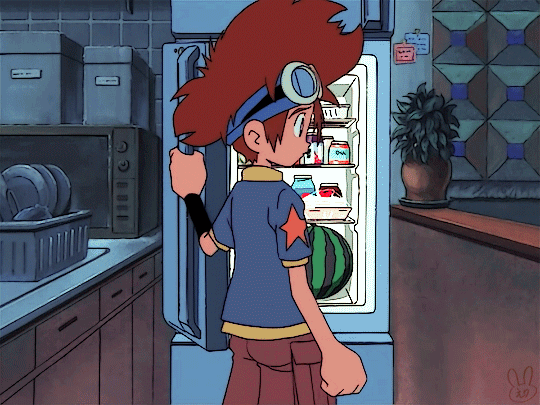
3. Kumiko Takahashi (Cardcaptor Sakura [1998-2000], Birdy The Mighty[1996])


4. Takahiro Yoshimatsu (Trigun[1998], Slayers franchise[1995-97])


5. Atsuko Nakajima (Ranma 1/2[1989-1992], You're Under Arrest[1996])

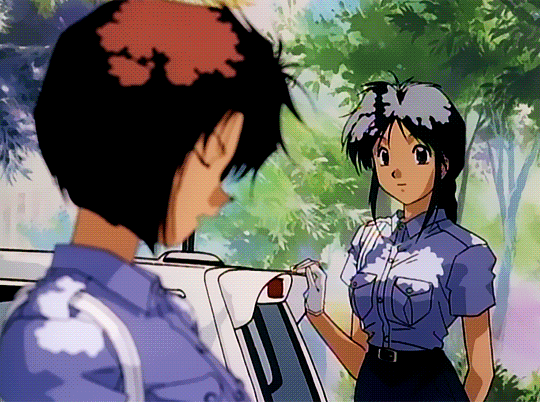
6. Sayuri Ichiishi (Pokémon[Pokémon design: 1996-present, human character design: 1996-2017])

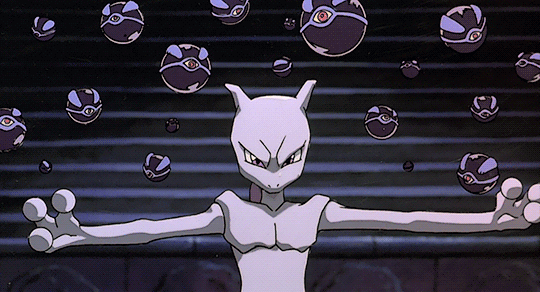
7. Atsuko Ishida (Magic Knight Rayearth[1994-1995])


8. Masaya Onishi (Yu Yu Hakusho[1993-1994])


9. Toshihiro Kawamoto(Cowboy Bebop[1998-1999], Mobile Suit Gundam: The 08th MS Team[1996])

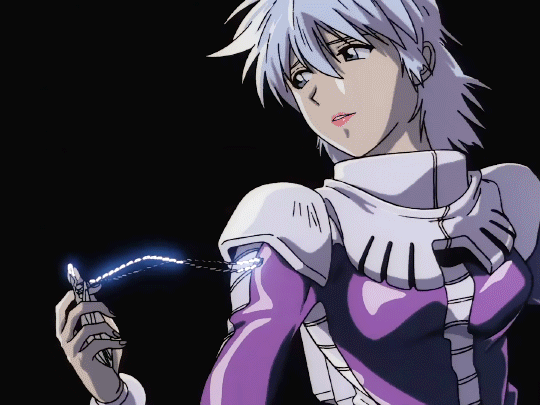
10. Hiroshi Osaka(Gundam franchise[Mobile Suit Victory Gundam: 1993-1994, Mobile Fighter G-Gundam:1994-1995])


11. Yoshiyuki Sadamoto(Nadia: The Secret of Blue Water[1990-1991], Neon Genesis Evangelion franchise[1995-1997, 2007-2021])


Might've leaned a bit more on the Shonen side of things than Shojo, but I hope you can see my point😅. There are tons of 90s anime out there with their own unique feel and aesthetic. These are only 11 names that I found.
For anyone drawing 90s anime style fanart, I hope this has given you some inspiration, and I encourage anyone reading this to look up your favourite anime on Anime News Network's encyclopedia and see who's responsible for helping bring your favorite characters to life on screen and what other shows they've worked on.
#90s anime#anime aesthetic#sonic cd#gundam#yu yu hakusho#dragon ball#digimon#digimon digital monsters#pokemon#pokemon anime#cardcaptor sakura#slayers#the slayers#trigun#birdy the mighty#tetsuwan birdy#ranma 1/2#ranma ½#you're under arrest#taiho shichauzo#magic knight rayearth#neon genesis evangelion#nadia the secret of blue water#roujin z
314 notes
·
View notes
Text
《My Fairy Tail Fanart Collection! (Pt.3)》
May 2021









We skip from March to May! I was pretty busy on April so I didn't draw anything (I remember it was junior high graduation exams back then). So I pretty much went ham on May xD.
Zervis is THE best. If it wasn't for NaLu they'd be my top 1 ship. The 100YQ Beta Heaven chapter gave me LIFE.
There's that one Jerza art I made as a DTIYS entry @/cagysole16 on Instagram! Jerza is my 3rd favorite ship after NaLu and ZerVis.
It's interesting but expected to see some different coloring styles here, I've always loved experimenting. I should do that more actually...
#art#artwork#digital art#fanart#fairy tail#nalu#zervis#jerza#my art#old art#i hate tagging#imma give up
228 notes
·
View notes
Text
COME ONE, COME ALL to the MOSTE ILLUSTRIOUS TOURNAMENT of the FINEST, the MOSTE PUISSANT and HOTTEST MEN MEDIEVAL MEDIA HAS TO ITS CREDIT.
Be it known that we shall accept submissions of the hottest men OF THE PEOPLES’ CHOOSING from any live-action* TV or movie media property set between the years AD 500 – 1550 (Tudors WELCOME!!), and any fantasy properties which emulate said period!
KNOW ALSO that we, by the grace of this fine hellsite and with the counsel of the moste honorable and illustrious @hotvintagepoll (many thanks), have made
THESE GUIDELINES here given:
ANY HOT GUY who appears in any movie or TV show released in ANY YEAR, from ANY COUNTRY, shall be deemed eligible for entry. Below are listed examples of eligible properties. If YE BE NOT CERTAIN whether your hot guy is eligible, submit him anyway!
Examples of Eligible Properties: The Lord of the Rings Trilogy (2001-03), Game of Thrones (2011-19) House of the Dragon (2022), Wolf Hall (2015-2024), The Tudors (2007-2010), Ladyhawke (1985), The Princess Bride (1987), The White Queen (2013), Rise of Empires: Ottoman (2020-2022), Vikings (2013-2020), The Last Kingdom (2015-2022), Diriliş: Ertuğrul (2014), A Knight’s Tale (2001), BBC’s Robin Hood (2006-3009), The Last Duel (2021), The Story of Minglan (2018), The Borgias (2013), Robin Hood (1939), Outlaw King (2018), Pilgrimage (2017), Legend (1985), Braveheart (1995), The Green Knight (2021), Excalibur (1981), Beowulf & Grendel (2005), The Lion in Winter (1968), Robin Hood: Men in Tights (1993), The Black Adder (Blackadder Series 1, 1982), Rashomon (1950)
Remember: This is just a list of examples—WOW ME!
These following titles are examples of properties that do not fall within or emulate the stated time period and therefore DO NOT QUALIFY: The Three Musketeers (Any Version), Pirates of the Caribbean (2004), Barbarians (2020), Gladiator (2000), Ben Hur (1959), Shogun (2024), Elizabeth (1999), 300 (2006), Troy (2004), Xena: Warrior Princess (1995-2001), Disney's Robin Hood (1973)**, Yojimbo (1961), Shakespeare in Love (1998), King Arthur (2004)***
For the purposes of this tournament, "Man" and "Guy" are defined as any bi-pedal humanoid male character played by a man. As such, characters belonging to non-human races such as Hobbits, Orcs, Elves, Demons, Fauns, Werewolves etc. ARE admissible, and, indeed, encouraged.
If you have propaganda you forgot to include in your submission, just hold onto it and send it in an ask after the Tournament begins.
You may submit as many hot men as you like but please submit only ONE ENTRANT per submission.
Do not hesitate to submit ANY hot guy you think may qualify, no matter how popular he is. There is no such thing as a shoo-in with these tournaments. If you think "Someone MUST have submitted him already!" Everyone else is probably thinking that too and then he may well NEVER get submitted and we don't want that.
Do not worry about how many submissions your hot guy might have had already--I need to get a sense of who the strongest contenders are in order to fairly seed the draws, and the best way to do that is volume of submissions.
We are voting on the hotness of the characters. While the actors who portray them are of course a major factor in this, we are not voting on the actors themselves, therefore propaganda pertaining to the actors real lives (aside from anecdotes relating to their portrayal of the character) is not admissible.
By that same token, in the case of historical figures (e.g. Henry VIII) we are judging hotness based on the fictionalized portrayals of them in these properties, not on historical fact.
Regarding immortal/time-travelling/dimension-hopping/extremely long-lived characters, regardless of when the character was born, the main action**** of the story must take place within the Medieval Period (see dates listed at the top of this post) or Medieval-esque fantasy fantasy realm in order for them to be eligible for submission. As such, characters like the Pevensie brothers (The Chronicles of Narnia) and Ash Williams (Army of Darkness) are admissible, but Asgardians (the MCU Thor films) are not.
I, as the Administrator and Master of Revels of this tournament, am exercising discretion in the admittance of characters from works by Shakespeare, since many of them have no set date.
Re: characters adapted from books/written works - Book quotes by/ about your character are not admissible as Propaganda for their tv/ movie counterparts unless said quotes were also written into the show/movie.
Book illustrations and fanart are not admissible Propaganda
SUBMISSIONS SHALL REMAIN OPEN UNTIL MIDNIGHT, JULY 1st
The Tourney shall begin at a date yet to be determined with the Melee (Qualifying Rounds), wherein the entrants with the fewest submissions and least propaganda will duke it out in a free for all brawl to determine who will enter the Lists.
SUBMIT YOUR ENTRANTS HERE TODAY!!!
-- Master of Revels

*The "live-action" qualification does have a caveat: exception may be made for those CGI films which were all the rage in the mid-00's that used the motion-capture and likeness of the actors; for example characters from, Robert Zemeckis's Beowulf (2007) are admissible.
** this one doesn't qualify, not because it isn't the right time period, but because it falls solidly under the "Animated" category.
***Yes, sadly we are deprived of the beautiful countenances of Clive Owen, Mads Mikkelsen, Ioan Gruffudd et al because the producers of this film in their infinite wisdom and in an attempt to seem "more historically accurate" chose to set it during the Roman withdrawal from Britain, which occurred in the 5th Century (About a CENTURY earlier than Authurian tradition) and is generally agreed to have ended by AD 410. It therefore does not fall under the Medieval umbrella and is not eligible for submission.
**** "Main Action" here defined as "More than half an hour of a movie and more than two episodes of a series"
#medieval fantasy#asoif/got#lord of the rings#a knight's tale#the last kingdom#vikings#the princess bride#house of the dragon#medieval films#tumblr polls#fantasyandmedievalmelee#tournament poll#game of thrones#got
135 notes
·
View notes
Text
━━ ✶✶˖° 𝗪𝗜𝗞𝗜𝗣𝗘𝗗𝗜𝗔 𝗣𝗥𝗢𝗙𝗜𝗟𝗘 | 𝗡𝟰𝗦.


𝗽𝗮𝗶𝗿𝗶𝗻𝗴(𝘀) ━ 2019 to 2023!f1 grid x driver!female oc
𝗮𝘂𝘁𝗵𝗼𝗿 𝗻𝗼𝘁𝗲 ━ english is not my first language, I know I already said it but just in case hshshsh also I know there are some things that may not be accurate but let’s pretend they are for the sake of the fic 😙👌🏻
𝘁𝗮𝗴𝗹𝗶𝘀𝘁 ━ @namgification @burberryfilms


ARABELLA TORRES GONZÁLEZ
Spanish racing driver

Arabella Torres González (born May 26 2000) is a spanish racing driver. In 2016 and 2018 she won the Formula Two championship. In 2019 she acquired a place in Formula One with Scuderia Ferrari, in 2021 she signed an eight-year contract with Mercedes.

Name Arabella Torres González
Nickname(s) La diabla, Bella Donna, Speedy
Born 26 may 2000 (age 21) Leganés, Madrid, Spain
Nationality 🇪🇸 Spanish
Relatives Oliver Torres (brother)

Teams Ferrari, Mercedes
Active years 2019 —
Car number 9
Wins 18
Podiums 41
Career Points 859
Pole positions 13
Fastest laps 8
First entry 2019 Australia Grand Prix
First win 2019 Spanish Grand Prix
Last win 2021 Turkish Grand Prix
2021 position 2nd (393)
Website arabellatorres.com

She is known for being the only woman to be an official Formula One driver since Giovanna Amati in 1992 and the second female driver with points since Lella Lombardi in 1976, thus creating history in the world of motorsport. At the 2019 Spanish Grand Prix she took her first victory, becoming the first woman in history to win a grand prix.
After a competition against Valtteri Bottas with whom she remained tied in terms of points during the last three races of the 2019 season, she won the title of sub champion in the drivers' world championship giving Ferrari the second place in the constructors' world championship.
In 2020 she suffered a horrible accident that made her unable to finish the Tuscan Grand Prix, after that race her results during the last eight races went down.
In the 2021 Abu Dhabi Grand Prix she returned to the podium (and in the championship) in second position after a close competition against Max Verstappen due to losing control of her car causing both of them to almost collide, but she managed to regain control and finish the race without no harm.
Her younger brother, Oliver Torres, is a Moto GP driver for Yamaha Motor Racing.
𝗕𝗜𝗢𝗚𝗥𝗔𝗣𝗛𝗬 ↓
Arabella was born in Leganés, a Madrid’s municipality, on 26 may 2000, as the eldest of two siblings: she and her little brother, Oliver Torres. Since she was a little girl she grew up with Formula 1 at home, as her father was a big fan and never missed a race although she was not too interested in the motor world of until one of her uncles gifted her brother a mini kart for christmas that she ended up using it, which sparked her curiosity about cars.
Her interest in cars began to grow, she began to watch Formula 1 with her father and her uncle, she noticed car brands and models and was passionate about car movies. She has mentioned several times that the Fast And Furious saga is one of her favorites.
From December 2018 to December 2020 she resided in Monte Carlo, Monaco. In 2021 she bought an apartment in London, England with her partner, the spanish football player Hector Bellerin. She currently lives between Monte Carlo and London.
𝗖𝗔𝗥𝗘𝗘𝗥 ↓
Torres began her racing career in karting at the young age of 9, competing in different categories. She won the Spanish Championship in the novice category in 2009, won the cadet category in 2010 and two more consecutive times. In 2013, in the KF3 European Championship she had a horrible accident when she reached second place, thus being the only race that she has not finished, a tire on her car burst causing her to fly several meters until she crashed into a fence in front of the stands. She had several spinal injuries and had to undergo surgery several times so she had to retire for a year, losing the opportunity to be signed by the Red Bull Junior Team.
At the age of 14, a year after her accident she returned to the world of motorsport in Formula 3 with Prema PowerTeam, finishing in sixth position in the FIA Formula 3 European Championship, in 2015 she finished on the podium in second position.
In 2016 she signed with the Ferrari Driver Academy and entered Formula 2 where she won first place in the 2016 and 2018 seasons.
Two years later, in 2019, she was announced as a driver for Scuderia Ferrari for Formula 1 alongside Charles Leclerc. During her contract with Ferrari she raced 38 races of which she won 9 and came second in the 2019 drivers' championship.
On December 13 2020, during the race in Abu Dhabi, Ferrari announced that Torres would not be part of the team for the following season and a week later it was announced that she would be replaced by Carlos Sainz Jr. On March 2 2022 during the presentation of their new car Mercedes announced, after almost three months of confusion about Arabella's future in Formula 1, that the driver had signed a contract with them for a duration of eight years, that is, until 2029.
𝗥𝗘𝗦𝗨𝗟𝗧𝗦 ↓
𝗥𝗘𝗖𝗢𝗥𝗗𝗦 ↓
𝗣𝗨𝗕𝗟𝗜𝗖 𝗜𝗠𝗔𝗚𝗘 𝗔𝗡𝗗 𝗔𝗖𝗛𝗜𝗘𝗩𝗘𝗠𝗘𝗡𝗧𝗦 ↓
𝗢𝗧𝗛𝗘𝗥 𝗩𝗘𝗡𝗧𝗨𝗥𝗘𝗦 ↓
𝗛𝗢𝗡𝗢𝗨𝗥𝗦 𝗔𝗡𝗗 𝗔𝗖𝗛𝗜𝗘𝗩𝗘𝗠𝗘𝗡𝗧𝗦 ↓
𝗡𝗢𝗧𝗘𝗦 ↓
𝗥𝗘𝗙𝗘𝗥𝗘𝗡𝗖𝗘𝗦 ↓
𝗘𝗫𝗧𝗘𝗥𝗡𝗔𝗟 𝗟𝗜𝗡𝗞𝗦 ↓
#max verstappen x reader#carlos sainz x reader#charles leclerc x reader#lando norris x reader#lewis hamilton x reader#female driver#female original character#driver!reader#f1 x reader#f1 fanfic#f1 fic#daniel ricciardo x reader#sergio pérez#alex albon x reader#fernando alonso#wikipedia#pierre gasly
147 notes
·
View notes
Text
Linkrot

For the rest of May, my bestselling solarpunk utopian novel THE LOST CAUSE (2023) is available as a $2.99, DRM-free ebook!

Here's an underrated cognitive virtue: "object permanence" – that is, remembering how you perceived something previously. As Riley Quinn often reminds us, the left is the ideology of object permanence – to be a leftist is to hate and mistrust the CIA even when they're tormenting Trump for a brief instant, or to remember that it was once possible for a working person to support their family with their wages:
https://pluralistic.net/2023/10/27/six-sells/#youre-holding-it-wrong
The thing is, object permanence is hard. Life comes at you quickly. It's very hard to remember facts, and the order in which those facts arrived – it's even harder to remember how you felt about those facts in the moment.
This is where blogging comes in – for me, at least. Back in 1997, Scott Edelman – editor of Science Fiction Age – asked me to take over the back page of the magazine by writing up ten links of interest for the nascent web. I wrote that column until the spring of 2000, then, in early 2001, Mark Frauenfelder asked me to guest-edit Boing Boing, whereupon the tempo of my web-logging went daily. I kept that up on Boing Boing for more than 19 years, writing about 54,000 posts. In February, 2020, I started Pluralistic.net, my solo project, a kind of blog/newsletter, and in the four-plus years since, I've written about 1,200 editions containing between one and twelve posts each.
This gigantic corpus of everything I ever considered to be noteworthy is immensely valuable to me. The act of taking notes in public is a powerful discipline: rather than jotting cryptic notes to myself in a commonplace book, I publish those notes for strangers. This imposes a rigor on the note-taking that makes those notes far more useful to me in years to come.
Better still: public note-taking is powerfully mnemonic. The things I've taken notes on form a kind of supersaturated solution of story ideas, essay ideas, speech ideas, and more, and periodically two or more of these fragments will glom together, nucleate, and a fully-formed work will crystallize out of the solution.
Then, the fact that all these fragments are also database entries – contained in the back-end of a WordPress installation that I can run complex queries on – comes into play, letting me swiftly and reliably confirm my memories of these long-gone phenomena. Inevitably, these queries turn up material that I've totally forgotten, and these make the result even richer, like adding homemade stock to a stew to bring out a rich and complicated flavor. Better still, many of these posts have been annotated by readers with supplemental materials or vigorous objections.
I call this all "The Memex Method" and it lets me write a lot (I wrote nine books during lockdown, as I used work to distract me from anxiety – something I stumbled into through a lifetime of chronic pain management):
https://pluralistic.net/2021/05/09/the-memex-method/
Back in 2013, I started a new daily Boing Boing feature: "This Day In Blogging History," wherein I would look at the archive of posts for that day one, five and ten years previously:
https://boingboing.net/2013/06/24/this-day-in-blogging-history.html
With Pluralistic, I turned this into a daily newsletter feature, now stretching back to twenty, fifteen, ten, five and one year ago. Here's today's:
https://pluralistic.net/2024/05/21/noway-back-machine/#retro
This is a tremendous adjunct to the Memex Method. It's a structured way to review everything I've ever thought about, in five-year increments, every single day. I liken this to working dough, where there's stuff at the edges getting dried out and crumbly, and so your fold it all back into the middle. All these old fragments naturally slip out of your thoughts and understanding, but you can revive their centrality by briefly paying attention to them for a few minutes every day.
This structured daily review is a wonderful way to maintain object permanence, reviewing your attitudes and beliefs over time. It's also a way to understand the long-forgotten origins of issues that are central to you today. Yesterday, I was reminded that I started thinking about automotive Right to Repair 15 years ago:
https://www.eff.org/deeplinks/2009/05/right-repair-law-pro
Given that we're still fighting over this, that's some important perspective, a reminder of the likely timescales involved in more recent issues where I feel like little progress is being made.
Remember when we all got pissed off because the mustache-twirling evil CEO of Warners, David Zaslav, was shredding highly anticipated TV shows and movies prior to their release to get a tax-credit? Turns out that we started getting angry about this stuff twenty years ago, when Michael Eisner did it to Michael Moore's "Fahrenheit 911":
https://www.nytimes.com/2004/05/05/us/disney-is-blocking-distribution-of-film-that-criticizes-bush.html
It's not just object permanence: this daily spelunk through my old records is also a way to continuously and methodically sound the web for linkrot: when old links go bad. Over the past five years, I've noticed a very sharp increase in linkrot, and even worse, in the odious practice of spammers taking over my dead friends' former blogs and turning them into AI spam-farms:
https://www.wired.com/story/confessions-of-an-ai-clickbait-kingpin/
The good people at the Pew Research Center have just released a careful, quantitative study of linkrot that confirms – and exceeds – my worst suspicions about the decay of the web:
https://www.pewresearch.org/data-labs/2024/05/17/when-online-content-disappears/
The headline finding from "When Online Content Disappears" is that 38% of the web of 2013 is gone today. Wikipedia references are especially hard-hit, with 23% of news links missing and 21% of government websites gone. The majority of Wikipedia entries have at least one broken link in their reference sections. Twitter is another industrial-scale oubliette: a fifth of English tweets disappear within a matter of months; for Turkish and Arabic tweets, it's 40%.
Thankfully, someone has plugged the web's memory-hole. Since 2001, the Internet Archive's Wayback Machine has allowed web users to see captures of web-pages, tracking their changes over time. I was at the Wayback Machine's launch party, and right away, I could see its value. Today, I make extensive use of Wayback Machine captures for my "This Day In History" posts, and when I find dead links on the web.
The Wayback Machine went public in 2001, but Archive founder Brewster Kahle started scraping the web in 1996. Today's post graphic – a modified Yahoo homepage from October 17, 1996 – is the oldest Yahoo capture on the Wayback Machine:
https://web.archive.org/web/19960501000000*/yahoo.com
Remember that the next time someone tells you that we must stamp out web-scraping for one reason or another. There are plenty of ugly ways to use scraping (looking at you, Clearview AI) that we should ban, but scraping itself is very good:
https://pluralistic.net/2023/09/17/how-to-think-about-scraping/
And so is the Internet Archive, which makes the legal threats it faces today all the more frightening. Lawsuits brought by the Big Five publishers and Big Three labels will, if successful, snuff out the Internet Archive altogether, and with it, the Wayback Machine – the only record we have of our ephemeral internet:
https://blog.archive.org/2024/04/19/internet-archive-stands-firm-on-library-digital-rights-in-final-brief-of-hachette-v-internet-archive-lawsuit/
Libraries burn. The Internet Archive may seem like a sturdy and eternal repository for our collective object permanence about the internet, but it is very fragile, and could disappear like that.

If you'd like an essay-formatted version of this post to read or share, here's a link to it on pluralistic.net, my surveillance-free, ad-free, tracker-free blog:
https://pluralistic.net/2024/05/21/noway-back-machine/#pew-pew-pew
279 notes
·
View notes
Text

2024 in Review
In 2024, I posted 17 fics, ranging from 334 to 27,731 words. Although I feel I joined too many bangs this year, only six fics were bang collabs. Addionally, there were eight art collabs as well. I haven't counted the art pieces, though. However, it probably felt that much because there are nine collabs I'm currently working on for 2025. So, if you like my fics and art, please subscribe to me on AO3 for fics and art, and/or follow me on Tumblr.
Making a List, Checking it Twice (Rated: E | Word Count: 1,369)
Summary: Dean forgets a naughty list in the kitchen. There's only one person/angel who can have found it.
The year started smutty with my first fic for the 12 Days of Smutmas.
Heating Up a Snow Cave (Rated: E | Word Count: 2,907)
Summary: Caught in a blizzard, Cas and Dean have to find a way to warm each other up.
My second fic for the 12 Days of Smutmas.
You Ain't Him (Rated: T | Word Count: 840)
Summary: “Dean?” Dean winced. No. It couldn’t be. His entire body started to tingle as the gravel voice vibrated through him. A voice he thought he would never hear again. This wasn’t happening. He was gone. He was—
A little birthday fic for Dean Winchester.
Books, Pies, and Roommates (Rated: E | Word Count: 27,731)
Summary: Everything seemed easy when Castiel landed a job in Lawrence as a literature professor at KU. He even found a place to stay with his cousin in Topeka. But the daily commute quickly gets on his nerves and he begins looking for a room in town. When he finally lucks out on a house, it comes with a catch. His mysterious landlord/housemate works and lives in Topeka during the week, and will only be at home for the weekend while Castiel is back at his cousin’s to honor a promise he made. When Dean walks into his favorite pie shop, the new sales assistant takes his breath away. Steve is gorgeous, and part of the owner’s family. Dean doesn’t even mind that he picks up Gabriel’s stupid moniker for him. After all, Deano has one syllable more, and Dean will do anything to hear Steve’s voice just a little bit longer. Though, as breathtaking Steve might be, he isn't Angel. If only Dean's book-loving best friend weren't a mystery in himself — a guy who Dean has only met online, but who has slowly taken his heart away. And it seems that Dean isn't alone in his feelings. When the lines blur and fantasies merge three guys into one, disappointment and heartbreak seem to be inevitable.
Pinefest ( @deancaspinefest ) is always one of the highlights of the year and this year @kitshay claimed my fic and created some beautiful pieces. Besides, I had a great time writing this two-person love hexagon.
Maybe not yet, but eventually (Rated: T | Word Count: 1,032)
Summary: Screaming, Dean wakes from a nightmare, trapped inside his memories.
This is the first of several time stamps this year. This one was for my 2021 DCBB fic Maybe not a comedy (according to Jack), but he likes the happy ending that can be read as a standalone.
Setting Sail (Rated: T | Word Count: 334)
Summary: 1805: Nodding at Lieutenant Davies and Midshipman Alfie, and leaving command with Lieutenant Hester, Castiel walks towards his cabin when he sees him.
Another timestamp, this time for my 2022 Regency Big Bang fic Forty Shillings on the Drum. Written for the Tumblr May Trope Mayhem. Can be read as standalone.
Maybe not magnificent, but damn awesome (Rated: T | Word Count: 1,137)
Summary: Movie nights aboard the Impala have become something of a routine after they reunited Sam with his family on Terra. Once a week, Charlie picks some classic movie from back in the days, and their little found family comes together in the living room.
Timestamp number three, once again for my 2021 DCBB fic Maybe not a comedy (according to Jack), but he likes the happy ending. Another entry for the May Trop Mayhem. Should work as standalone.
Filling the Empty Space in My Heart (Rated: T | Word Count: 5,035)
Summary: After Cas let himself be taken by the Empty, Dean's life continues in a blur. Only Jack keeps him going, who has turned himself into an actual four-year-old boy after defeating Chuck and giving up the majority of his powers to stabilise Heaven. However, Dean knows he isn't good enough to raise a nephil. Jack needs his dad. And there might be one way to bring him back. Even if it leads Dean back to Hell, and beyond.
Inspired by an art piece for the DCRB 2024 where I ended up empty handed, and written for the Profound Bond Gift Exchange as a gift for @thecadenceimperfect. With art by me. I later wrote a smutty timestamp as well called:
A Place to Stay (Rated: E | Word Count: 3,157)
Summary: After getting back from the Empty, Dean’s entire body tingled, too edgy for his skin. He barely paid attention to the others and couldn’t stop fidgeting since he had returned to the library and joined them once again at the table. Cas’ presence was electric, pulling him into its orbit. Dean felt it in every fibre of his being as he slumped down on the chair next to him. Echoes of Grace pulsed through him, and for the first time since Cas pulled that stupid stunt and let himself be swallowed by the Empty, Dean felt alive.
TFW 2.0: Siren Adventures (Rated: E | Word Count: 4,727)
Summary: After Charlie and Sam's plan to save Cas and Dean goes sideways, Charlie doesn't give up. There must be another way. When she finds help in an unsual ally, the future is suddenly starting to look brighter.
My Crack in the Chassis catch ( @crack-in-the-chassis ) for @notreallyaroad 's fic TFW: Just Add Water. At first, I claimed for art, but due to the special kind of bang, we agreed for me to write an alternate ending / fix-it as well.
A Part of Me Shall Still Remain (Rated: T | Word Count: 6,918)
Summary: In 1805 Commander Castiel returns home after long years at sea. The Battle of Trafalgar has left him a broken man. For years, he shuns society and withdraws to his estate, until a scandal involving Sir Castiel’s disgraced cousin and a young noblewoman shakes the ballrooms of London and Bath. It introduces him to a doomed woman, who not only does approve of his deepest secrets, but who also does give birth to a child that will alter the commander’s life forever.
My fic for the Dadstiel Bang ( @dadstielminibang ) with stunning art by @twinone1221. This fic is set in the verse of my 2022 Regency Big Bang fic Forty Shillings on the Drum, but can be read as standalone. I had two other collabs for the Dadstiel Bang, both art.
Everlasting Fall (Rated: E | Word Count: 3,136)
Summary: Tendrils of Grace trickled from Dean’s fingers as his hand ghosted along Castiel’s flank. Gasping, Castiel shivered and Dean smiled. “You like that?” Stripped of their combined Grace for the night, Castiel gives himself over to Dean, ready to be taken apart.
Another timestamp because after demon and angel smut, I wanted to write some Grace kink. Set in my Calming the Weather verse.
That's Purrfect (Rated: T | Word Count: 1,262)
Summary: Castiel would do anything for him. He would level entire civilisations for Dean Winchester, or dress as a cat — it didn’t matter as long as Dean was happy.
Another Halloween fic to add to my annual tradition, and the only fic I managed to write for Suptober this year.
Highly Professional (Rated: E | Word Count: 25,565)
Summary: On his first day of college, Dean feels like a fish out of water. After years of working his ass off with several jobs at once to fund his brother’s studies, his family and friends have decided to pay him back. That’s how he finds himself panicking in the lecture hall. Thankfully, a fellow student distracts him. She promptly becomes a good friend, and Dean has no idea how badly he will need her. The moment he lays eyes on his physics professor, Dean is lost. Castiel Novak seems like the man of his dreams. And when the professor’s son appears from under the podium, several lives take an unsuspected turn.
My fic collab for the DCBB 2024 with wonderful art by @sasanka-27. I started this fic for the Dadstiel Bang, but changed it for the one I ended up with.
Your Own Personal Heaven (Rated: T | Word Count: 3,004)
Summary: After arriving in Heaven, Dean's nursing a beer in the crowded and snowed-in Roadhouse when the door opens and Cas enters. Crowding him, Dean makes out with him in front of everyone present, believing that he is stuck in his personal Heaven and none of it is real.
I haven't shared this Christmas fic on Tumblr before because I was too busy with bang collabs and the holidays. Inspired by a prompt by @macy2me.
It's a Stabby Life (Rated: T | Word Count: 4,370)
Summary: Dean Smith’s life as Director of Sales and Marketing at Sandover seems perfect. If there weren’t the dreams, and his new colleague. When he runs into Castiel and accidentally stabs him with a knife in the cafeteria, the guy walks away as if nothing happened. Maybe it didn’t and Dean is simply overworked. But then it happens again, and again, and Dean’s perfect life slowly falls to pieces.
The first of two fics for @deancas-stabfest. @arlington-chamber-of-gay claimed it an created beautiful pieces for the stabs. I had never written Dean Smith before, so this was really fun.
Gonna Find Out Who's Naughty or Nice (Rated: T | Word Count: 8,859)
Summary: During a case involving an entire coven of witches, Dean tries on a Santa hat. Nothing seems wrong, until he can’t remove the hat. Jingles start following his every step while his body changes. Slowly at first, then faster and faster, until he can’t hide it any longer from Sam and Castiel: Dean is transforming into Santa, and there seems to be no way back.
My Stabfest collab number two is the last fic for this year. This time, I claimed a wonderful art piece by @masoenart. It was the second collab with @masoena this year after our collab for the Midam Bang during the summer where our roles were reversed. One reader called this fic Christmas horror. I just had a lot of fun writing it.
Art Collabs
(you find the links to the fics when you follow the links to the art, either on AO3 or Tumblr)
Destiel Pinefest 2024: Art for 'Given to Fly' by MittenWraith, colalb with @mittensmorgul [art on Tumblr]
Bottom Cas Big Bang 2023/2024: Art for 'Raising Kids, Finding Love, the Family Business' by Mydestielbabies_67, collab with @spnisthewayoflife [art on Tumblr]
Dadstiel Mini Bang 2024: Art for 'Make a Wish' by Avonlady, collab with @avonlady42 [art on Tumblr]
Art for 'Always Memorable' by golbygloom, collab with @golby-moon [art on Tumblr]
Crack in the Chassis 2024: Art for 'TFW: Just Add Water' by notreallyaroad, collab with @notreallyaroad [art on Tumblr]
Midam Bang 2024: Art for 'Breaking Light — A Future Earned' by Masoena, collab with @masoena [art on Tumblr]
DCBB 2024: Art for 'Marriage of Heaven, Hell & Humanity' by draechaeli, collab with @draechaeli [art on Tumblr]
Stabfest 2024: Art for 'Monsters and Men' by FriendofCarlotta, collab with @friendofcarlotta [art on Tumblr]
Over the summer, I also posted several sketches I drew in my sketchbook.
And I posted some photos taken at PurCon which ended up my most shared posts of the year.
#destiel#destiel fanart#destiel fanfic#deancas fanfic#seidenapfel writes#seidenapfel arts#I hope all links work. Otherwise let me know and I change them.#seidenapfel masterlist
34 notes
·
View notes
Note
pardon me if you’re tired of discussing this but. we know aa7 is on capcom’s radar on some level. and now they’ve rereleased every game right?? they’ve finally run out of backlog material after almost yearly releases since 2019…. Not to put the clown wig and nose back on too early but do you think we’ll actually get news about, or get to see, aa7 next year?
Never tired of discussing this!! This is right around the time of year where I'd be preparing to make my yearly AA7 Speculation Post anyway so this is great timing. (TGS, my enemy, is approaching.)
So just to make sure everyone's on the same page, here's a quick recap of where we're currently at:
In November 2020 we got internal Capcom leaks which included a calendar from 2019 with the roadmap for the AA series the next couple of years. This included:
DGS1&2 collection, which I did not think was going to happen ever, releasing April-June 2021
AA7, releasing around October-December 2021, right around the 20th anniversary.
Through late 2019-mid 2022, reconsider porting 456
We got DGS1&2 (a bit later than in the plan, but by like a month), we got the 456 ports, we got bonus AAI ports, we have nothing for AA7 nearly three years after it was supposed to come out. The pandemic is an obvious feature that could contribute to its delay, but at this point with 456 ports out I think we can safely say that this was not the only cause.
Some other things that may or may not be contributing to AA7's delay include:
Yamazaki, the previous main writer for 5&6 and the AAIs, left Capcom in 2020. If he was involved in AA7 at all, that could throw a wrench into things, but I recall hearing he intended AA6 to be his last AA game (I AM STRUGGLING TO FIND THE SOURCE THOUGH SOMEONE PLEASE HELP ME), so I don't think this contributed very much. It does, however, mean that we're unsure about who the next main writer is - depending on what Takumi's up to or if they had to bring someone new on, there could be complications related to that.
I think TGAA did way better than anyone expected, which I covered in this post. It's possible that this could have shifted Capcom's priorities to porting more old games / porting to all modern consoles. It may have made people at Capcom think "damn everyone loves Takumi" so they tried to lure him back to AA7, and I have no idea how well that would have gone or if Takumi is even interested in continuing mainline AA right now. (I do think this at least contributed to the Ghost Trick ports.)
In my first ever AA7 speculation post I talked about how the ending of AA6 kind of wrote them into a corner re: how to continue with the series and which protagonist to use. I still stand by that argument even if a lot of that post aged badly.
Console ports! Previously new AA games were for whichever Nintendo handheld is out now (GBA, Nintendo DS, Nintendo 3DS). But now that the series is doing really well on all consoles, they may have decided to try to make their next mainline entry on all consoles, which would take more development time. Adding to this is that the Switch is near the end of its lifecycle with the Switch 2 (or whatever the successor will be) being announced soon - meaning that, if AA7 is coming out soon, Capcom is in the position of "do we try to squeeze this into the end of the Switch's lifecycle" (which, I'll need to find sources for this, is speculated to be some of the reasons behind why AAI2 and DGS2 sold badly when they were first released, and they can't make the same mistake thrice... right...?) or "do we try to time it with the release of the Switch 2"?
Also, a lot of this depends on how far AA7 was into development whenever it was derailed. If it was derailed from the pandemic, then according to the calendar, it would likely have still been in the prototype stage. It may be early enough that they would have had to start from scratch whenever they picked it up again. I don't work in the gaming industry so I have no idea how long it takes them to make a game or how easy it would be from what stage they're in.
One thing we can compare to is some of the comments about the recent AAI ports: in this interview, Shunsuke Nishida, the producer of the AAI collection, says that development on the collection began in 2022. He also mentions that this began once development on 456 was concluded. This leads me to believe that (contrary to my previous assumptions) 456 and AAIC were not developed concurrently (or if so, had very minimal overlap), and that the process of upscaling graphics, porting, and localization took them... about a year, maybe? So that takes time, even without taking into consideration how long it would take to come up with a new idea + write the script + the bulk of the programming that would have to be done that isn't considered with porting + probably way more than I can think of because again I do not work in the gaming industry.
There's also the question of why 456 and AAIC weren't developed concurrently. The calendar from 2020 shows that TGAA and AA7 were meant to be developed at least somewhat concurrently, and the staff from TGAA would eventually merge into working on AA7. Once again, we don't know what happened to the staff that were supposed to be working on AA7. It's possible pandemic complications meant they got shuffled onto other projects. It's possible the AA-related team is smaller now than it was in 2020, so they only have enough people to work on one project at a time. It's also possible that there's a team that was working on ports, and a team that was working on a new game, and now the "port team" is freed up to work on the "new game team".
Either way though, pretty much every interview with the staff for the 456 or AAI ports are all saying "look forward to the future of the series", which is definitely Corporate Speak, but unless they're bringing the ports of the Layton crossover (fingers crossed) that can only mean one thing. (AAI anime?) Plus, like I've discussed in this post, AA is having fantastic sales in general. They've seemingly either hired a new social media manager or changed the strategy so there is much more engagement on twitter. And AA is getting on bigger and bigger announcements - though AA trilogy ports were announced at TGS (at an AA-specific panel), TGAA duology ports were announced unceremoniously on twitter. Afterwards, 456 ports got announced at the Capcom Showcase during Summer Game Fest. And now AAI collection got announced at a Nintendo Direct, which I imagine is even more expensive, so the series must be going in a good direction for them to think that's worth it!
That's a lot of rambling for me to say I definitely think it's coming.
When are we going to see it though!!
Coming up in September is my eternal enemy Tokyo Game Show. Since AAI collection is being released at the beginning of September... it might be a bit too soon to announce a new game, but who knows. They might think it's profitable to ride the hype they're building now for AAI collection to announce a new game. Or they might let it sit for a while.
With AAIC getting announced at a Direct, I'm thinking they'll want to make AA7's announcement a) big and b) global. AA6 was announced in Famitsu, but the problem with that is that it's a mostly Japanese audience, and some interviews have been talking about how AA's global audience is particularly contributing to how big it is right now. So I'm expecting AA's next announcement to be at something major and something that will get attention from overseas audiences.
If they have been working on AA7 concurrently -- and honestly I do think there has at least been some progress on it since 2019 -- we could definitely see an announcement within the next year. I was also saying this in 2020, though, so don't take my word for it. There's been two year gaps between ports up until the AAI collection, and they seemed pretty proud about releasing 456 and AAI in the same year, so... maybe they'll want to keep it going and announce AA7 within the next year, especially if they'll have a longer announcement -> release period than they normally would for ports.
Potential candidates include:
Tokyo Game Show: As previously stated, it's very close to the AAIC release, so I don't think it's the best timing for it. I would not want my favorite AA game overshadowed by whatever the hell they're going to do with AA7. Likelihood: depends on how fast they want to follow up on the hype.
The Game Awards: is the next major gaming event, but that's already massive in terms of the type of games that get announced there, and it's expensive! Nintendo Direct is one thing since AA has always been a Nintendo-first series, but I don't think it's big enough to justify putting in a Game Awards ad. and I already have my clown wig on for persona 6 there. Likelihood: pretty low tbh
Next Year's Summer Game Fest-related Shows: I think this is the most likely, considering both the 456 collection and the AAI collection were announced around this time. For AA7 I'd say a Nintendo Direct to get lots of eyes on it, especially if AAIC sales pay off. Likelihood: pretty high!
Which leads me into my wildcard answer:
Switch 2 Announcement Stream: If Capcom decides to go in and make AA7 one of the first games for whatever the switch successor would be, it could be announced here. I regret to admit that I am a very bad gamer and only like two things, and therefore have not ever been present for one of these things to know how many games get announced as launch games for a new console, but, like, it's possible.
In the above scenario, I'm not necessarily saying that AA7 would be a Switch 2 exclusive - because I think that would be stupid after so much of the support they've gotten from the ports has been from playstation and steam - but I am definitely the kind of person who would buy a console for one video game. Shoutout to me buying a switch in part anticipating that aa7 would come out on it and that is not looking likely
Anyways, that's my speculation!! Reminder that this is mostly uninformed and that I have no knowledge of anything related to sales or marketing or video game development, and as a result of that, I have been wrong (aside from the one time I accurately predicted AAI ports as a joke) for four consecutive years.
#I hope this makes sense. it's kinda all over the place#asks#aa7 speculation#ace attorney#i am. so scared.
64 notes
·
View notes
Text
Genshin ships: stock market update (Natlan Act 3+4)
(Warning: May contain spoilers for character appearances and dynamics in [Chapter 5 Act 3–4] Beyond the Smoke and Mirrors and The Rainbow Destined to Burn. Previous entries here.) This is for entertainment purposes only and is not financial advice: consult with your ship financial advisor before you invest.
Citlali/Traveller — This ship has everything. Handholding. Accidental mind reading tropes. Fast friendships in middle age. Drunken soul-baring. Palm reading. Coparenting dynamics. They sat and watched the moon together. BUY.
Capitano/Traveller — HOLD. Solid starting potential but their interactions have all been too high stakes to get a sense of how their personalities interact.
Mavuika/Capitano — SELL OR HOLD. Too early to call; Act 5 could make or break this.
Mavuika/Xilonen — Our previous recommendation has changed; it's now a strong BUY. Our analysts say they haven't seen this level of weary fondness since 2021's "pay your fines, Captain", and Dainsleif hinting that Xilonen does everything in her power to avoid being around when Mavuika turns up is just icing on the cake.
Kinich/K'uhul Ajaw — HOLD. Just because two people are married doesn't mean there's a ship in there. Sometimes it's just for tax purposes.
Paimon/K'uhul Ajaw — SELL. The world's best travel guide deserves someone who will treat her with respect, such as... uh... Sorush?
Mehrak/K'uhul Ajaw — be serious.
Traveller/Teleport Waypoints — after Act 4? As if. SELL.
Enjou/Aether — BUY BUY BUY does this even need explaining?
Enjou/Lumine — HOLD. Our analysts hurriedly added, “Nonono it's not a gender thing, it's because Aether likes Pyro slimes and Lumine likes Cryo slimes more so really we should be shipping Lumine with the Maguu Kenki or something.”
Chasca/Shenhe — SELL. Bird mating rituals aren't nearly as fun without the possibility of oviposition. Or, um. So I heard. Stick with Xianyun/Kujou Sara.
Cyno/Kinich — *sigh*, no, SELL. Too (ki-)niche.
Ronova/Xbalanque — HOLD OR BUY. Btw, are we sure the Archon War made it west of Liyue? >_>
Citlali/Faruzan — HOLD. It's too early to compare their traumas for thematic compatibility, but it's not out of the question. Watch this space.
Citlali/Draff — *wince*
------
We tend not to advise on heavily optioned stocks due to all the short selling activity, but for those of you who were wondering:
Citlali/Ororon — too volatile to call. This is the first explicit (grand)parental relationship between playable characters, so it technically fills a niche, but it's unclear whether that's a niche anyone went into Genshin looking for.
Chuychu/Chasca — the analysts just gave me a really withering look so I guess SELL? "Too soon"? What's that supposed to mean? She's just resting her eyes, right?
Mavuika/Nahida — SELL OR HOLD. The motif of memories as fuel is great and all but Mavuika is way too young.
Ematol/Phonia — SELL. The worst part is that they're not even the kind of sisters where that would have any transgressive je ne sais quoi. They're just like flatmates. Bert and Ernie minus the chemistry.
And that's it for now. Keep an eye on the Sumeru market later this patch— we're expecting predictable dividend payouts on all the blue chip stocks.
#genshin impact#genshin ship market update#the rainbow destined to burn#doylist shipping#natlan spoilers#natlan#meta: pinned posts
45 notes
·
View notes
Photo

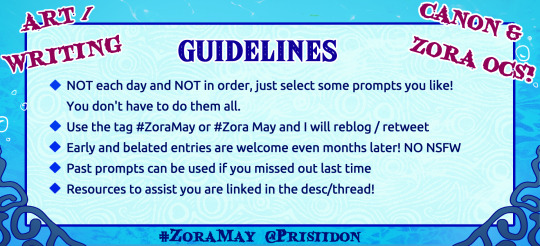
✨ Zora May 2023 - 5th anniversary ✨ Tag any of your zora-related art/writing! go fkn ham guys to celebrate both of these! >:) Resources below:
Design a Zora Masterpost | Random fish generator
Entries: tumblr entries | twitter entries | old twitter entries
Previous events: 2020-2021 | 2019 | 2018
EDIT: EXTENDED! (due to leaks, spoilers and totk release in May)
#zora may#zoramay#art prompts#writing prompts#loz#botw#totk#breath of the wild#legend of zelda#tears of the kingdom#tloz#sidon#loz botw#loz totk#prince sidon#mipha#king sidon#zora#zora oc#pri posts
664 notes
·
View notes